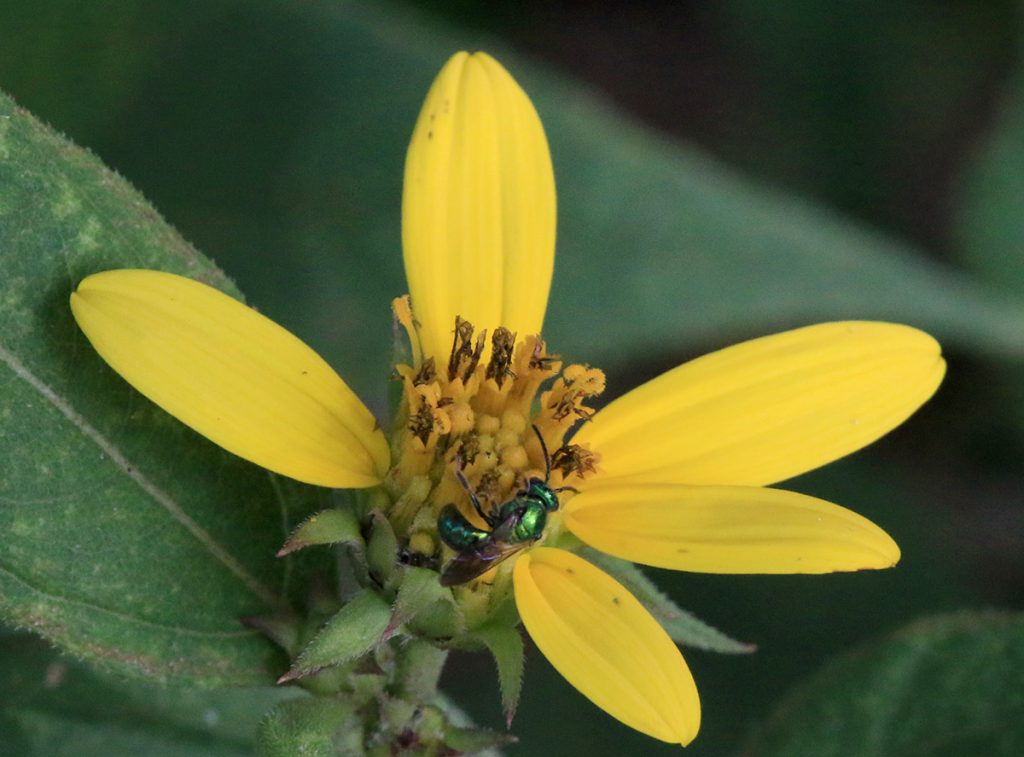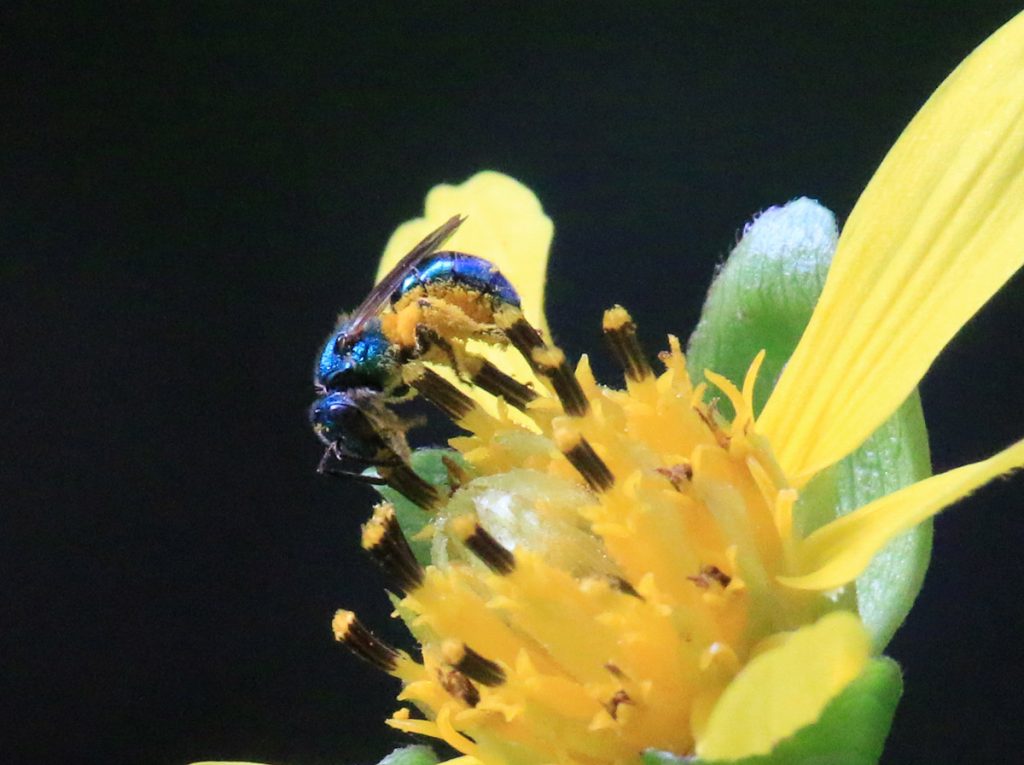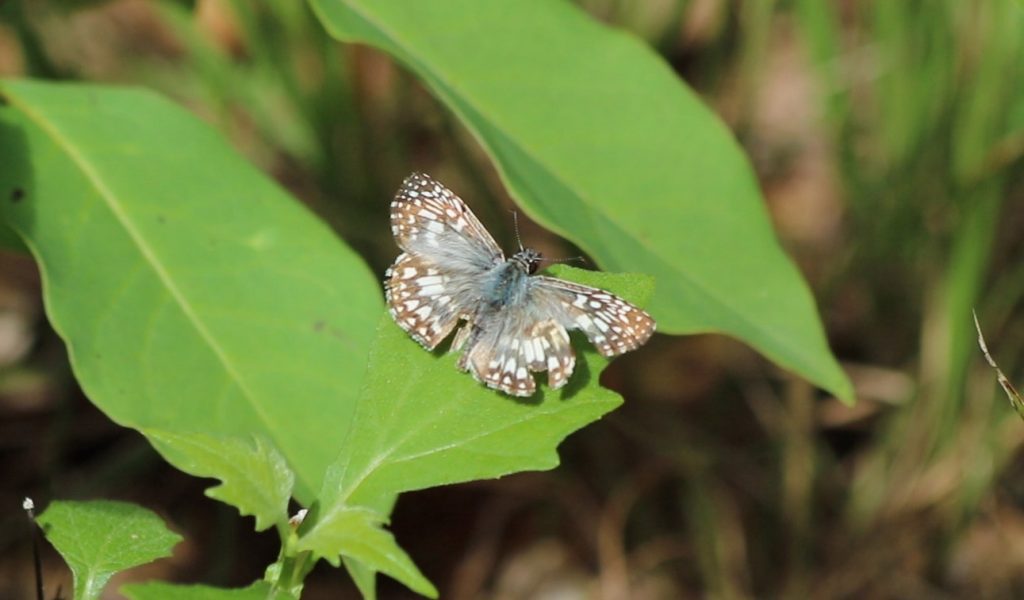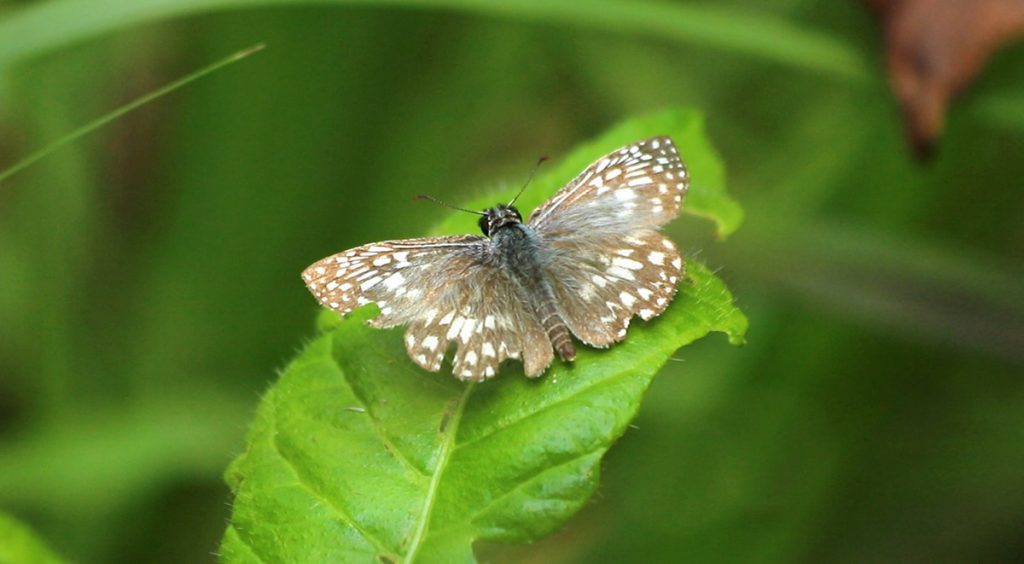The video above came from a craving to see a single animal. Five years ago, I met Dean and Sally Jue at Elinor Klapp-Phipps Park. They were in search of that single species of animal, a small brown butterfly with yellow stripes on its wings. The park is a Golden-Banded Skipper Preserve.
Golden-banded skippers are common from Arizona and New Mexico, down into Central America. The eastern population, however, is rare. The butterfly is listed as Imperiled in Florida; this park might be the most likely place to see one in the state. I just happened to be nearby with a camera one day, and the thought came to me to find it and photograph it again.
But, no, I didn’t see it then.
Walking down the power line cut, my camera kept finding so many other butterflies. And a wide range of native bees. I had to meet someone shortly after, and so my visit was short. I had to come back. And then, for good measure, come back again.
I saw the skipper on the next two visits. On that last trip, I also shot photos of the federally listed American bumblebee. I did a story on those last fall. I saw pollinators of every shape and size, as well as some other interesting insects.
The power line cut isn’t an official trail; it’s not on the park’s trail map. In fact, on my first couple of visits, it was a little overgrown. But that was perfect.
Before I move on to the next section, I wanted to thank Hot Tamale for the music used in the segment. They originally composed it for the EcoCitizen project, but I felt it was a nice fit for this video as well.

Pollinator Plants and Open Space
Elinor Klapp-Phipps Park exists largely to protect the Lake Jackson watershed. A lot of its trails wind through moist, shady hardwood forest. The power line cuts through that forest, creating a wide, cleared swath, and a lot of edge habitat. The cut is lined with flowering plants- sunflowers, devil’s walkingstick, spurred butterfly pea, butterfly milkweed, Carolina ruellia, sensitive plants, partridge pea, and on and on. Some of those are butterfly larval host plants, in addition to providing a bounty of nectar for the adults.
I spent two mornings walking that cut shooting mostly video, and a third shooting mostly stills. Just before that third visit, the city mowed the cut, removing many of the lower lying flowers. Additionally, the devil’s walking stick, which had been choked with bees, wasps, and butterflies, had mostly gone to seed. I saw fewer pollinators overall that day, but I also saw a few I hadn’t seen the first two times. And I saw other cool things, like mantises and katydid nymphs.
Watching the video, you’ll notice I organized it by flower species. What I’ll do in this post is run through the pollinator species we saw on each flower, and add in any photos of additional species that didn’t make it in. There were just too many to include all of them in so short a video.
Measuring it in Google Earth, I see that I covered about a quarter of a mile of that cut. It’s striking to me the diversity of insect life I saw on this short stretch. It’s a testament to what can happen when you make space for native plants and the animals that use them.
1. The Golden-Banded Skipper (Autochton cellus)
00:00 Before diving into the different flower species and their visitors, we highlight the star of the show on our title page. On my first two trips, I got there a little later than the optimal time to see golden-banded skippers. They are most active in the early morning and nearer to sunset. In the middle of the day, when other butterfly species are active in the full sun, they retreat to some shadier spots in the park. I remembered one such spot from my 2015 shoot, and there it was!
The western population of golden-banded skipper larvae has a more diverse diet of legumes than the eastern. The eastern population’s caterpillars eat one plant: the thicket bean. One reason Klapp-Phipps is a preserve for the animal is its healthy populations of the plant.
Another skipper that hosts on thicket bean is the much more common long-tailed skipper. That butterfly also hosts on several other bean species, and some consider it a garden pest. Long-tailed skipper caterpillars are known as bean rollers for their habit of curling leaves to make a shelter for themselves. The golden-banded tears the leaf to make little triangular leaf shelters. So if you come upon thicket bean at Klapp-Phipps, you may see both rolled leaves and little triangle tears.
2. Woodland Sunflower (Helianthus divaricatus)
00:08 Zebra longwing, aka zebra heliconian (Heliconius charithonia).
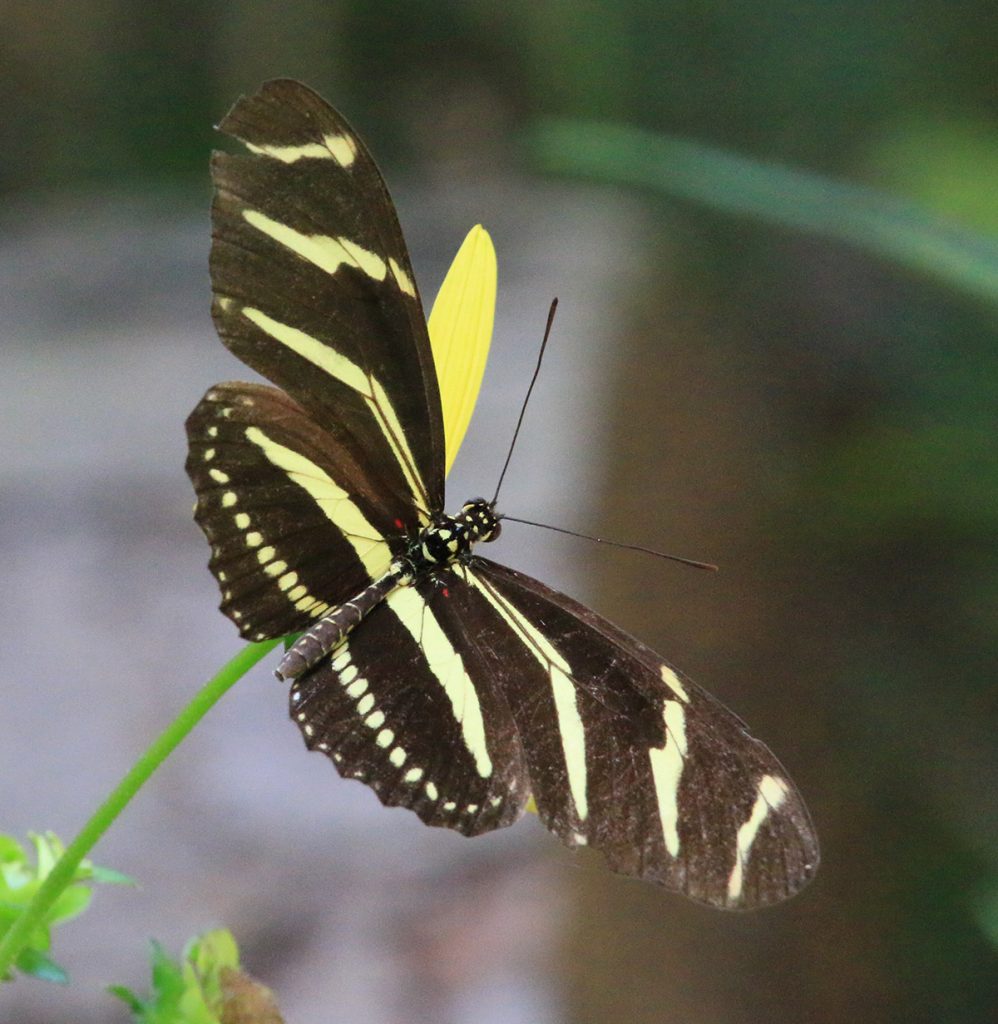
I like the following image of a zebra longwing resting on a leaf. The sun is illuminating its wings in a way that you can see green through them, from the leaves behind:
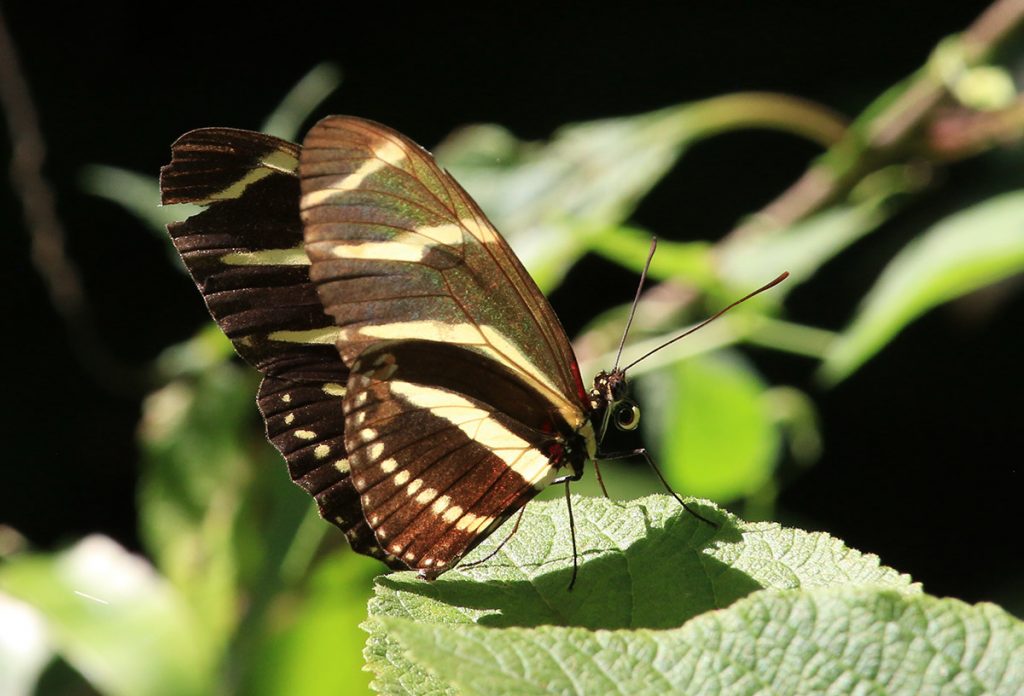
00:15 I’m testing my skipper identification skills here, but I’m fairly certain the following is a zabulon skipper (Poanes zabulon).
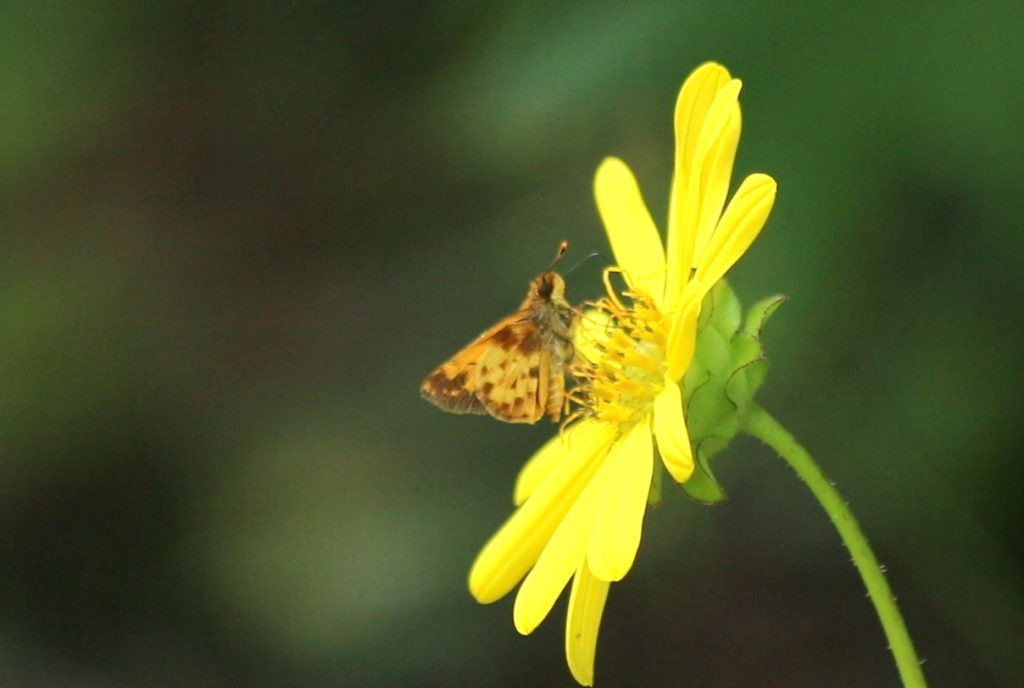
00:18 Feather legged scoliid wasp (Dielis plumipes)
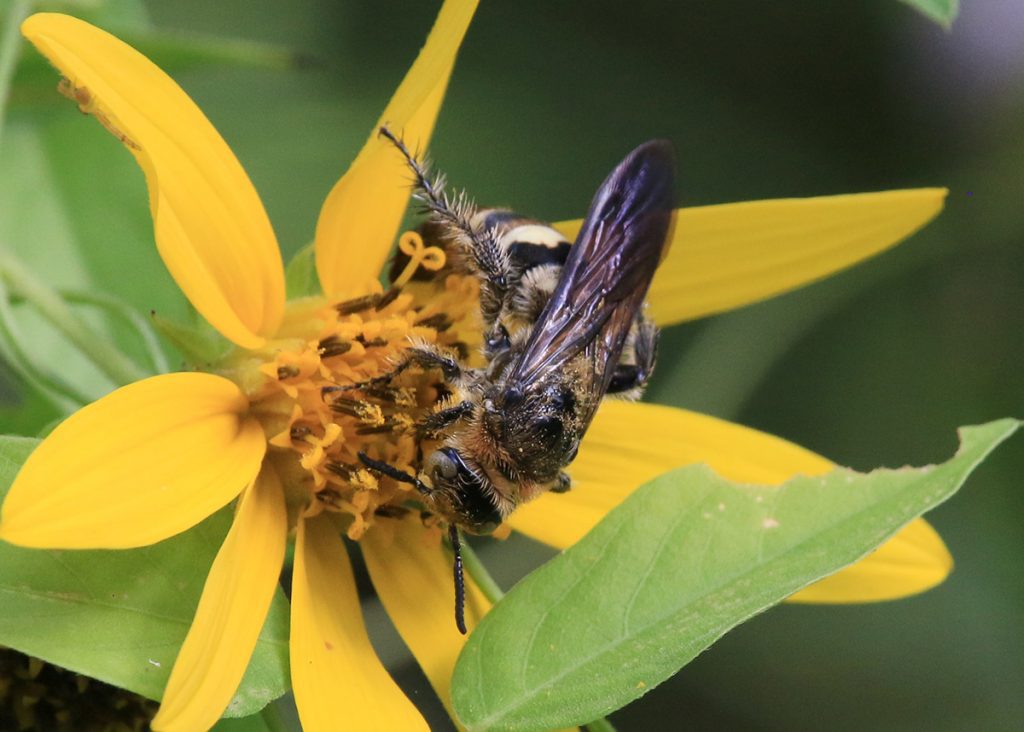
00:23 A leafcutter bee. Pugnacious leafcutter bee (Megachile pugnata) looked the most likely to me, but this doesn’t seem to be its range. Another possibility is Chelostomoides, a subgenus of Megachile (the genus of leafcutter bees).
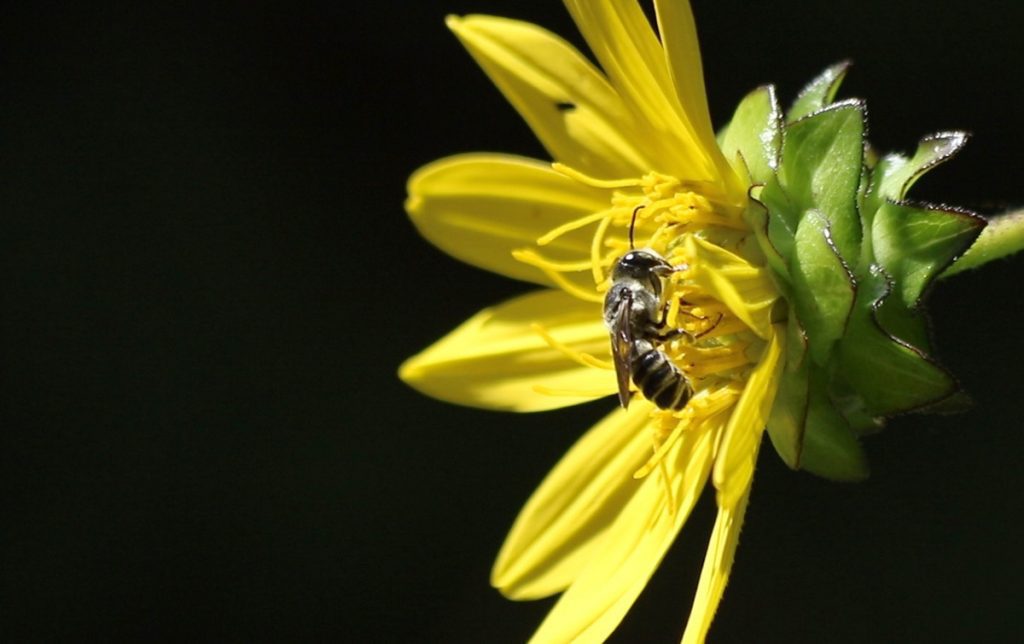
00:26 Horace’s duskywing (Erynnis horatius). I’ve also included a photo of a female I saw at the park, which has a higher contrast wing pattern. The female can be confused for other duskywings, one of which we’ll see in a second.

Male Horace’s duskywing (Erynnis horatius) 

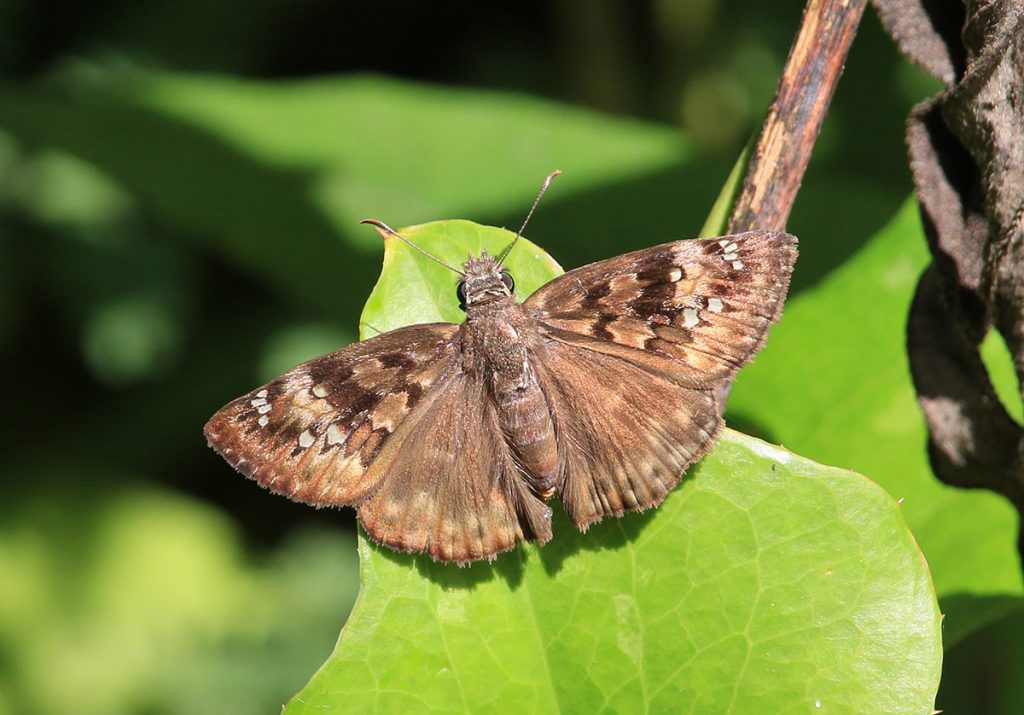
Female Horace’s duskywing (Erynnis horatius)
Other butterfly species I saw on sunflowers
So, what else did I see on sunflowers? More butterflies and bees, as you’d expect. But, as I’ve been seeing in my own yard lately, there were some predators as well. We’re in the peak months for insect activity, so the eating is good.
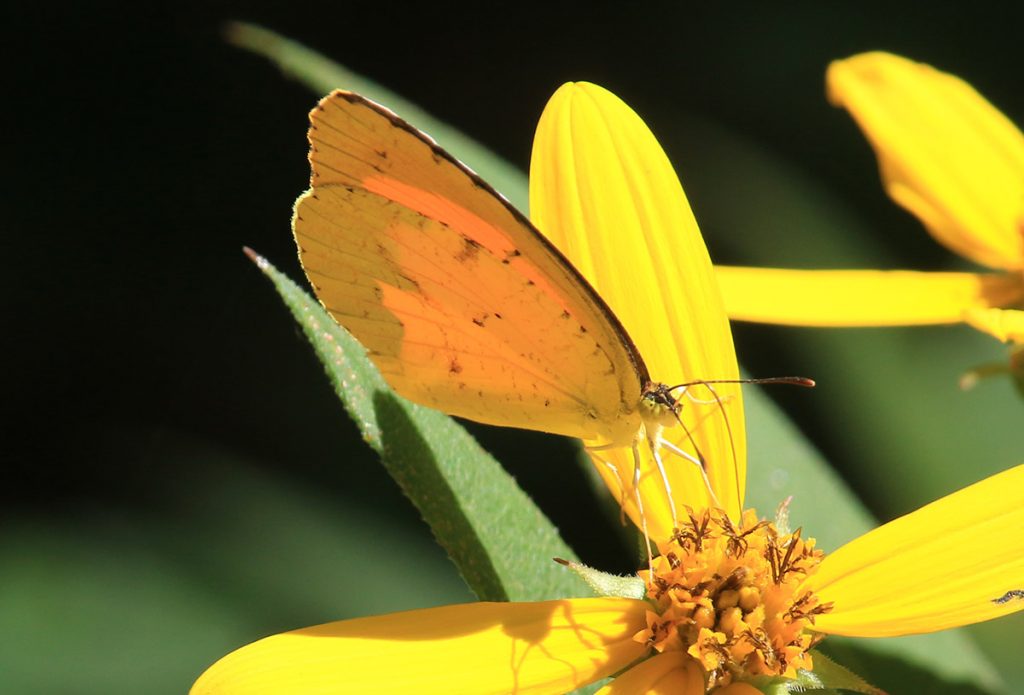

From their underwings alone, these can be hard to distinguish from other sulphurs. But I could see the orange on the tops of its wings as it flew from flower to flower. You can also see the black fringe of its upper wings show through to the other side.
Next, we’ll see a few skippers up close on woodland sunflowers. These butterflies aren’t as showy as monarchs, swallowtails, or any of the other larger species. I do think that they are cool looking when you get up close, though, and some are surprisingly colorful.
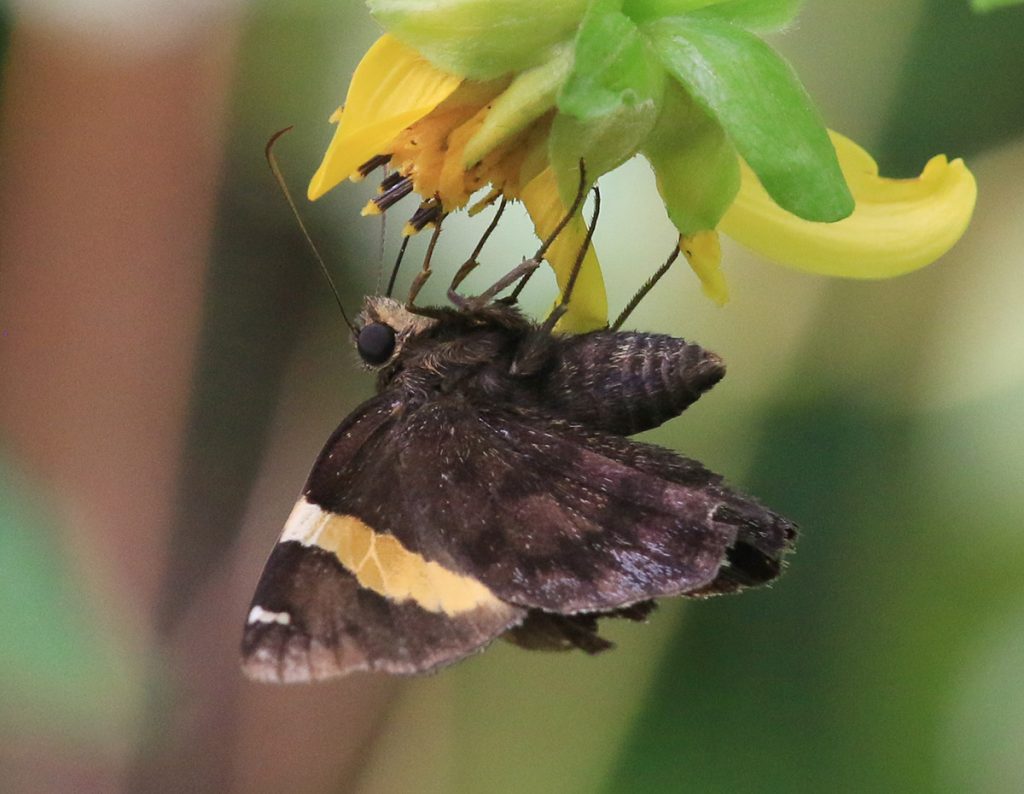

Here’s the star of our show. They’re much less shy than other butterflies, even when they’re not feeding. Once you find them, they make a cooperative photo subject.
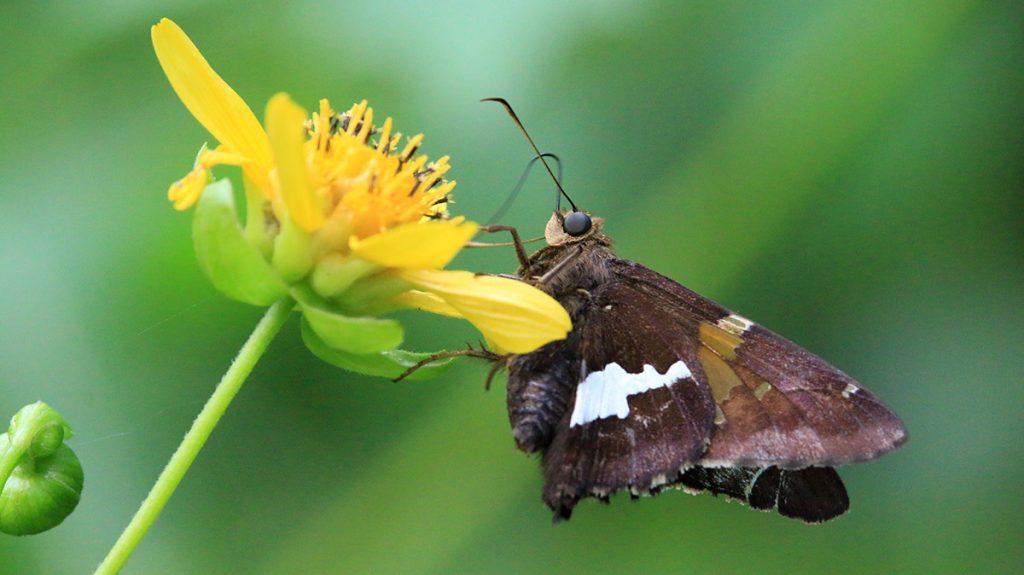

This one was near the golden-banded, and they occasionally went for the same flower. You can see that they look somewhat similar.
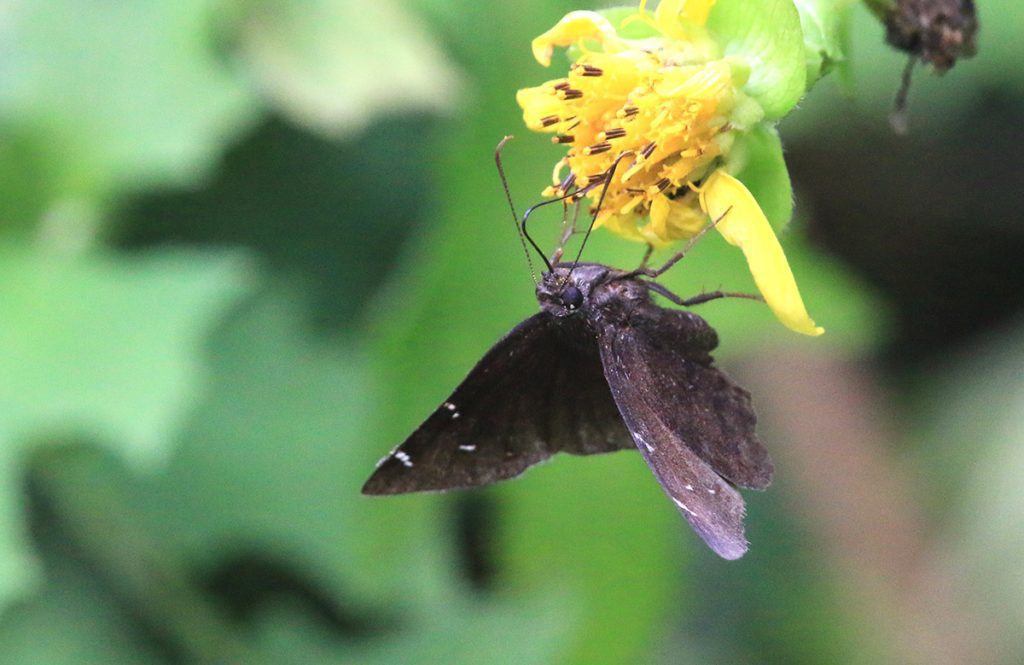

Clouded skippers lack even the small streaks of color of the previous two skippers. They might just be the plainest of our skippers. The next skipper, on the other hand, might be the prettiest:
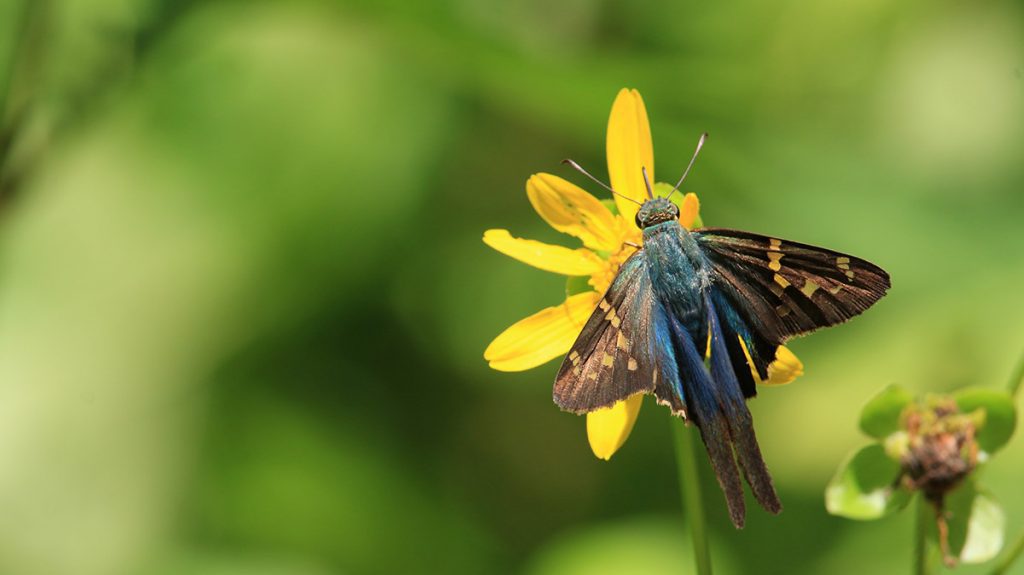

I’ve seen these a lot in our yard over the years, but I’m not sure I’ve taken a photo of one that shows off their blue like this one does. It was on a tall flower in an uncluttered spot, in full sun.
Other bees and wasps found on woodland sunflowers
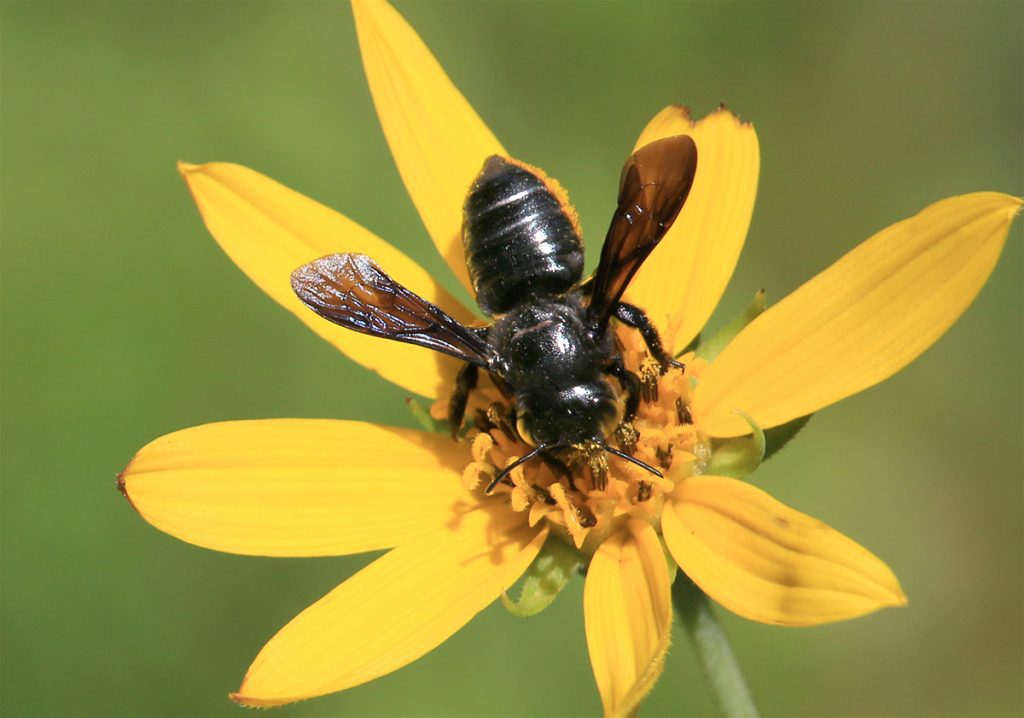

I tracked this one in flight for a little while before it landed. It’s all black, like the longhorn bees in my yard. But it’s smooth like a carpenter bee, and I’ve recently been seeing a female southern carpenter bee that is black and relatively hairless like this one.
Then I noticed this one has pollen on the underside of its abdomen, like I’ve seen in other leafcutters.
It turns out, this is a carpenter mimic leafcutter bee. We had a male of this species in our yard in May and June. Like a male carpenter bee, the male in my yard was fuzzy and brownish yellow, with a smooth black abdomen. This female mimics female southern carpenter bees. The mimics are even aggressive to other pollinators, like the larger carpenters.
I think the one on the left is a pure green sweat bee, which I have in my yard. The one on the right is shockingly blue, but pure green sweat bees are sometimes blue. We have a few other species of similar looking green sweat bees in the area, but none of them seem to have blue individuals, at least not in the photos I looked over.
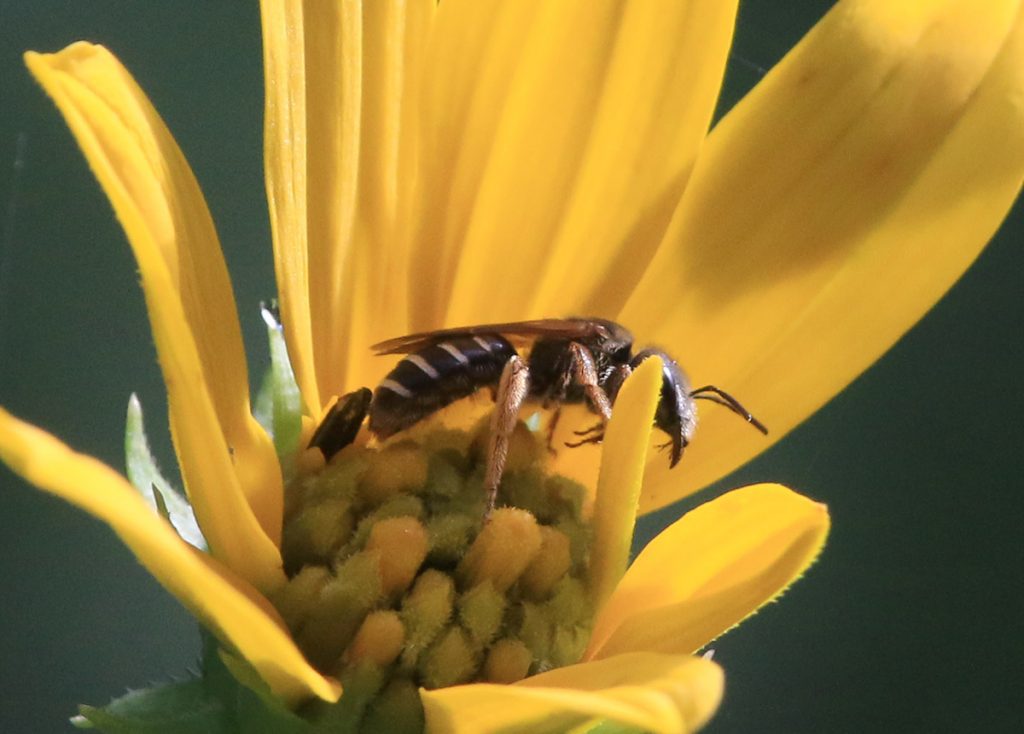

Here’s another sweat bee common to our yard, and all over Tallahassee.


Using iNaturalist, I’ve narrowed this down to the genus Netelia, part of a family of wasps called Ichneumonidae. These are parasitic wasps. According to this Bugguide article, they sting caterpillars to temporarily immobilize and lay eggs on them. The wasp larvae later hatch and feed on the caterpillar. Instead of consuming entirely it like some parasites do, Netelia allow the caterpillars to grow as they continue to feed on it.
Predators and other insects on woodland sunflowers
Like I said earlier, on my last visit, I saw less pollinators than on my first two trips. But I did see other types of insects and spiders, and many of them on the proliferation of sunflowers growing along the powerline cut.


We’ve already seen the diversity of pollinators that visit these flowers. It makes sense that the animals that eat those insects would visit the flowers as well. This one has hidden itself beneath the flower, waiting patiently.


This one is a little less stealthy.
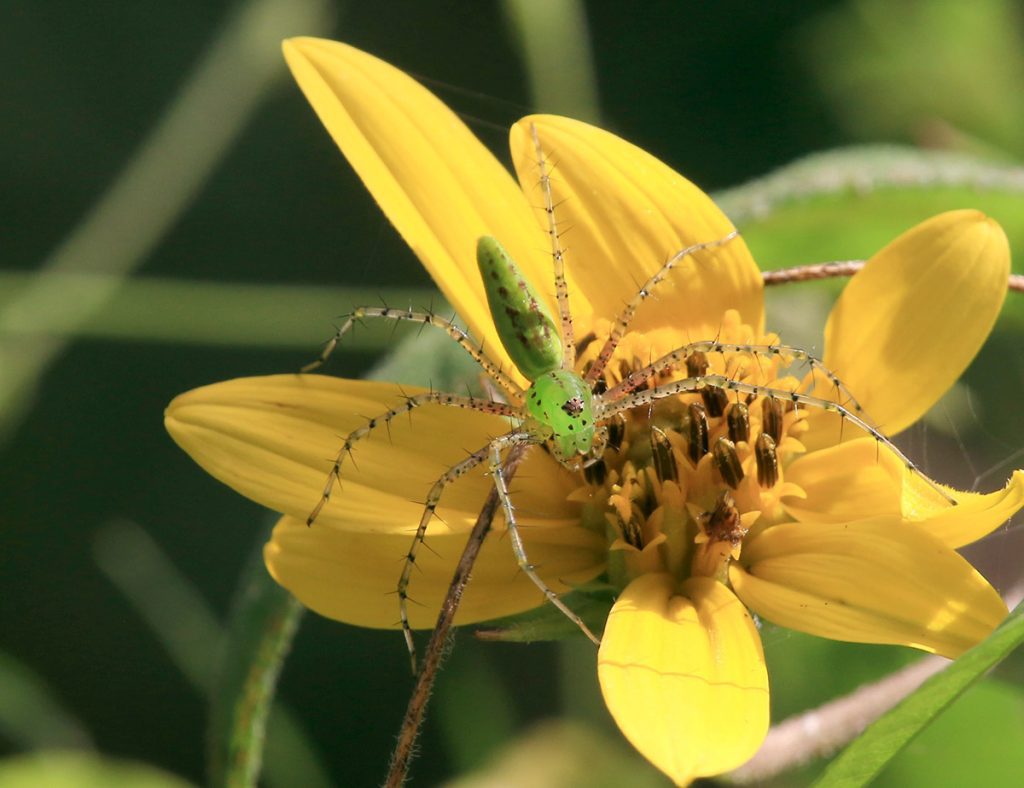

Green lynx spiders are impressive looking. My first thought is that, lying atop the flower, pollinators would see and avoid it. But smell draws them first. So, perhaps, already aimed and flying at the flower, they might not see the predator until it was too late?
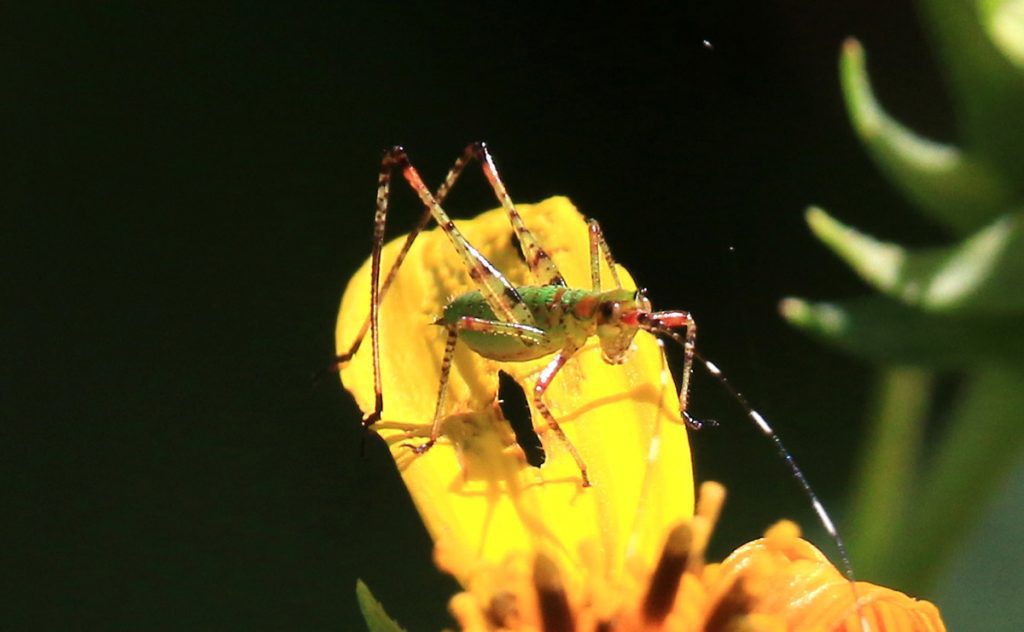

It was last July that I first encountered a katydid nymph in my yard. So, maybe July is about when katydids are reaching this life stage? iNaturalist and an expert user recognize this as a Scudder’s bush katydid, the genus Scudderia.
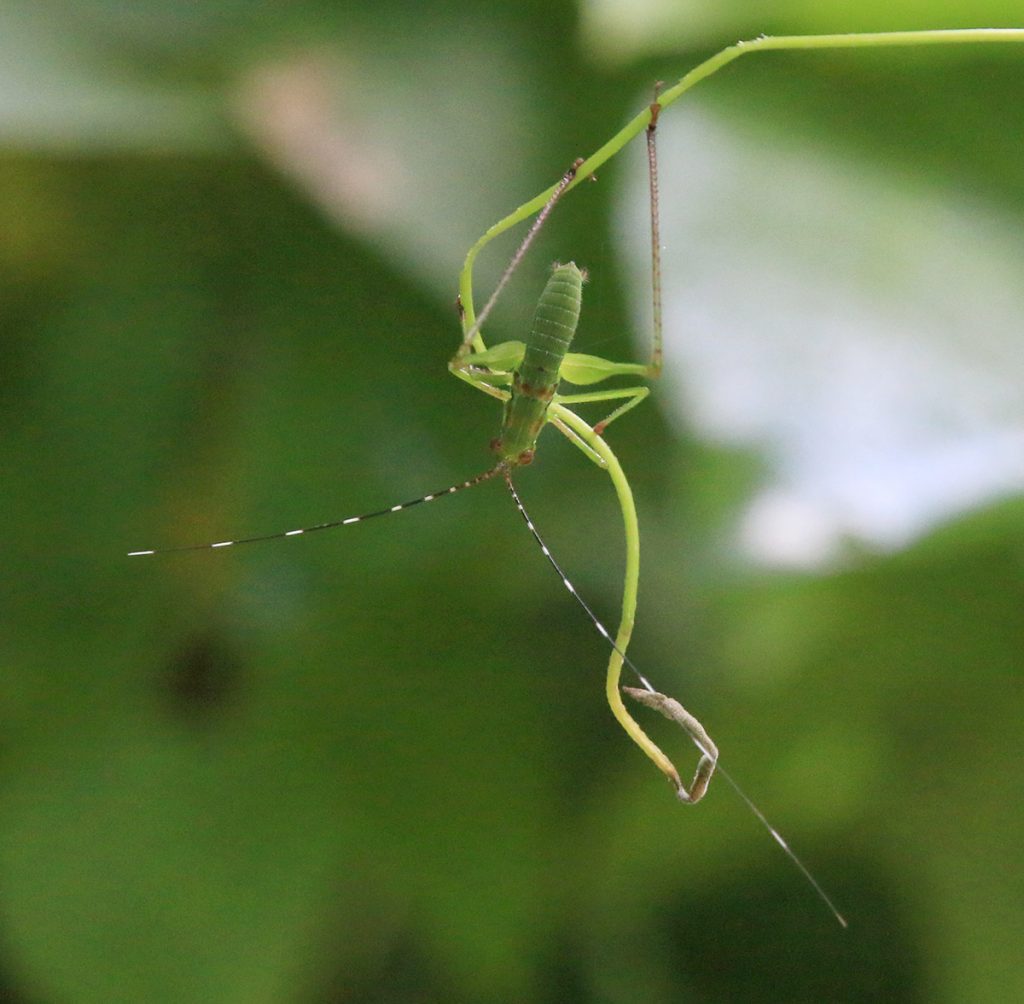

Here’s another one on a vine near a sunflower.
3. Butterflies sunning on leaves
Looking at just one flower species, we’ve counted examples of eight different butterflies, four or five different bees, two wasps, and three other insect or arachnid species. That’s looking at one kind of flower in that quarter mile stretch.
Now we look at a few butterflies catching sun along the powerline cut. Insects are cold blooded, like reptiles, and butterflies will sun themselves to bring their temperatures up. The open space of the cut has sun for flowers, and sun for butterflies as well.
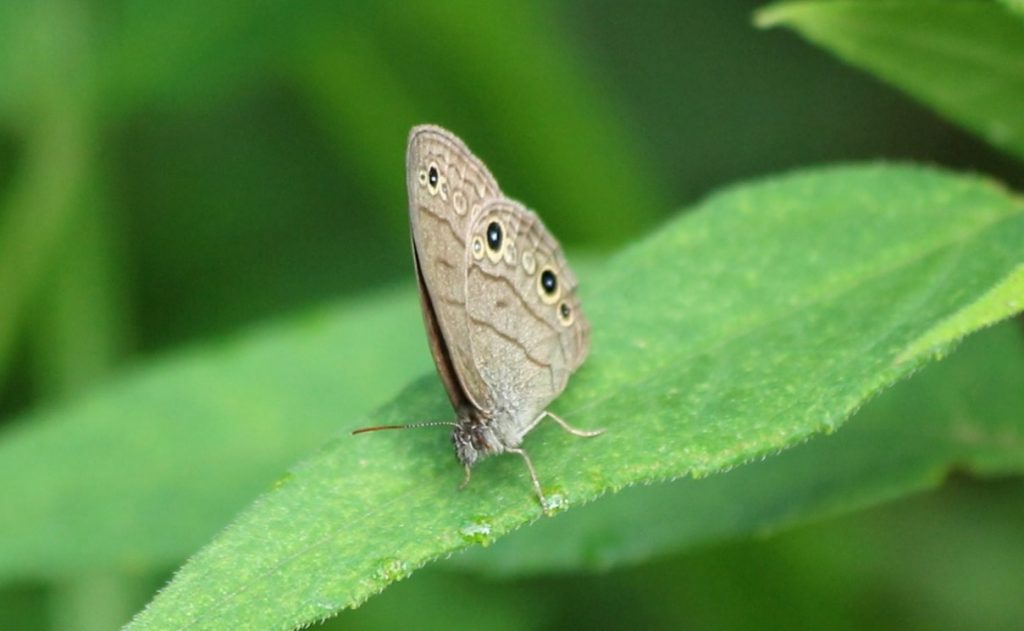

00:29 Carolina satyr (Hermeuptychia sosybius). This is a very small butterfly, but with a cool wing pattern when you take a close look.
00:31 I love the amount of wing damage butterflies can sustain and still fly. So I included two shots of tropical checkered skippers (Pyrgus oileus) with chewed up wings. What encounters did these two survive to end up with their cool battle scars?
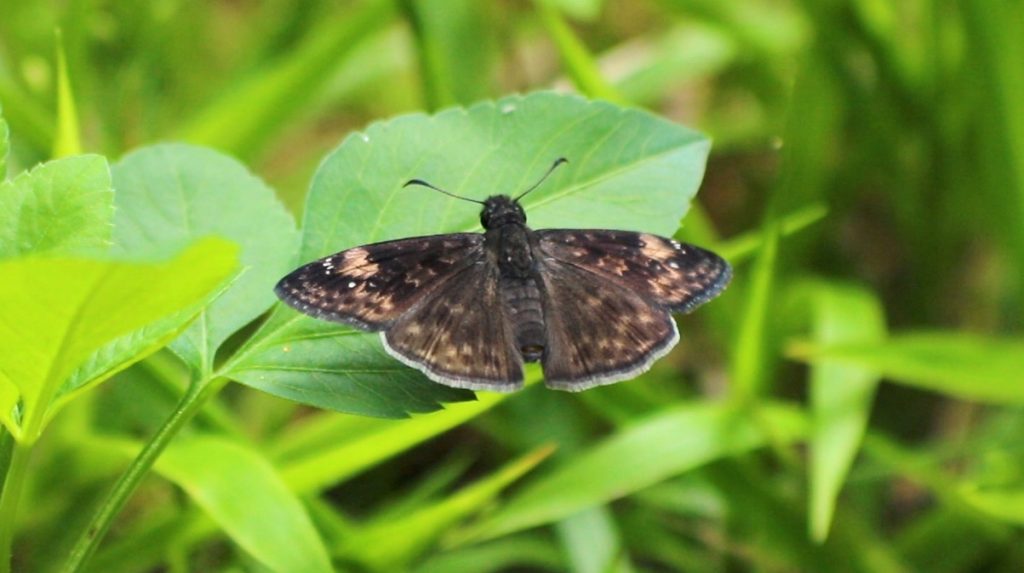

00:35 Zarucco duskywing (Eynnis zarucco). The duskywings are all small and brown, and have smilar patterns of white spots and lighter, tan bands. Let’s look at the Zarucco with the Horace’s:


Zarucco duskywing (Eynnis zarucco) 

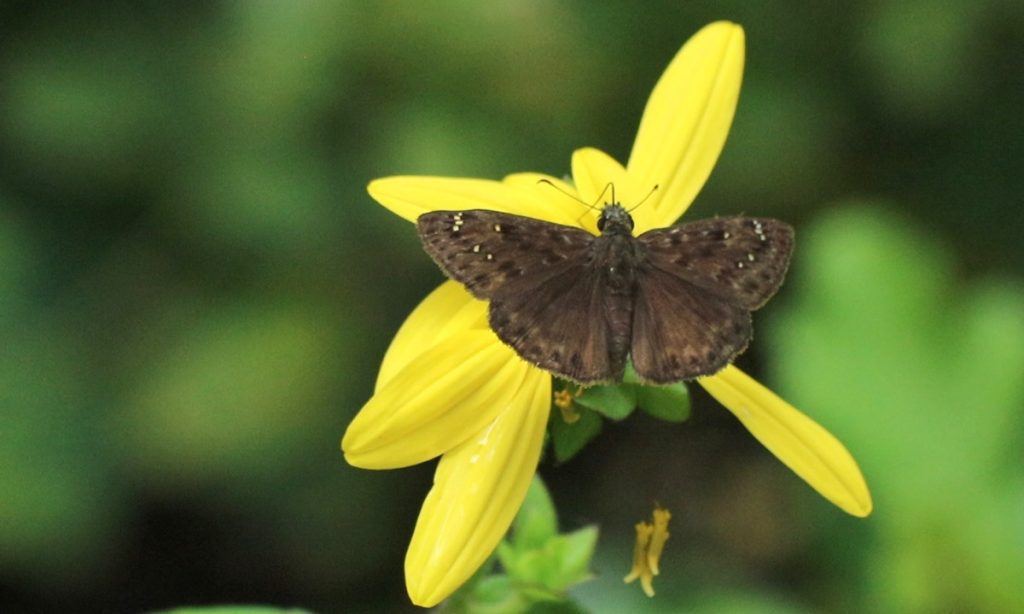
Male Horace’s duskywing (Erynnis horatius) 


Female Horace’s duskywing (Erynnis horatius)
The differences are subtle, but they’re distinct enough for me to feel secure identifying the butterfly on the left as a Zarruco duskywing.
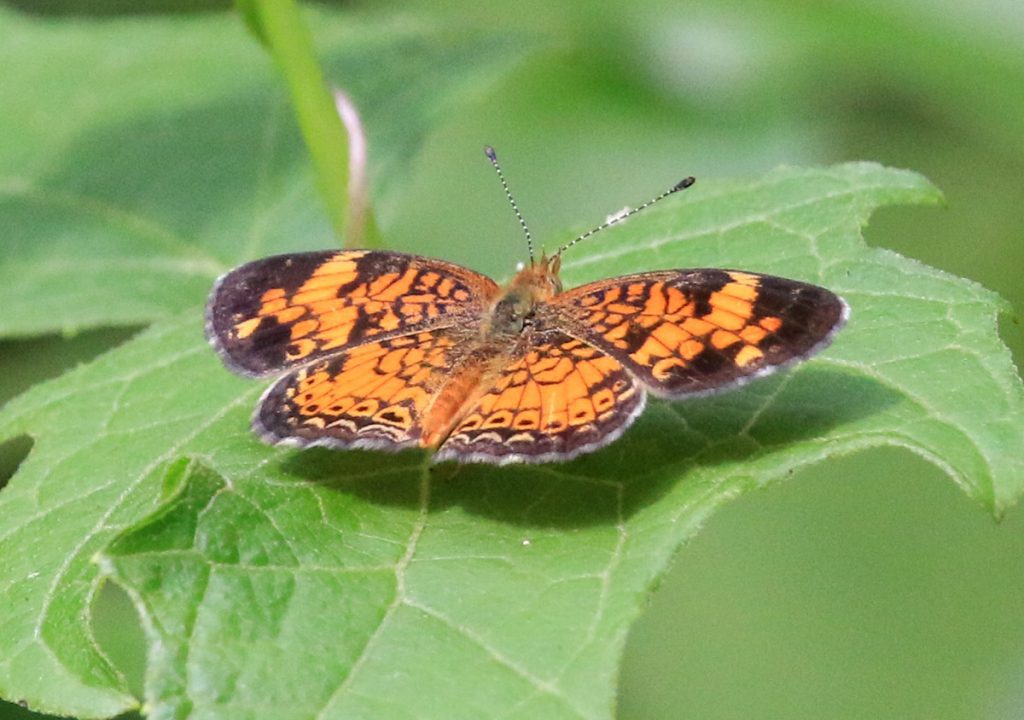

00:38 Pearl crescent (Phyciodes tharos)
Other pollinators catching sun
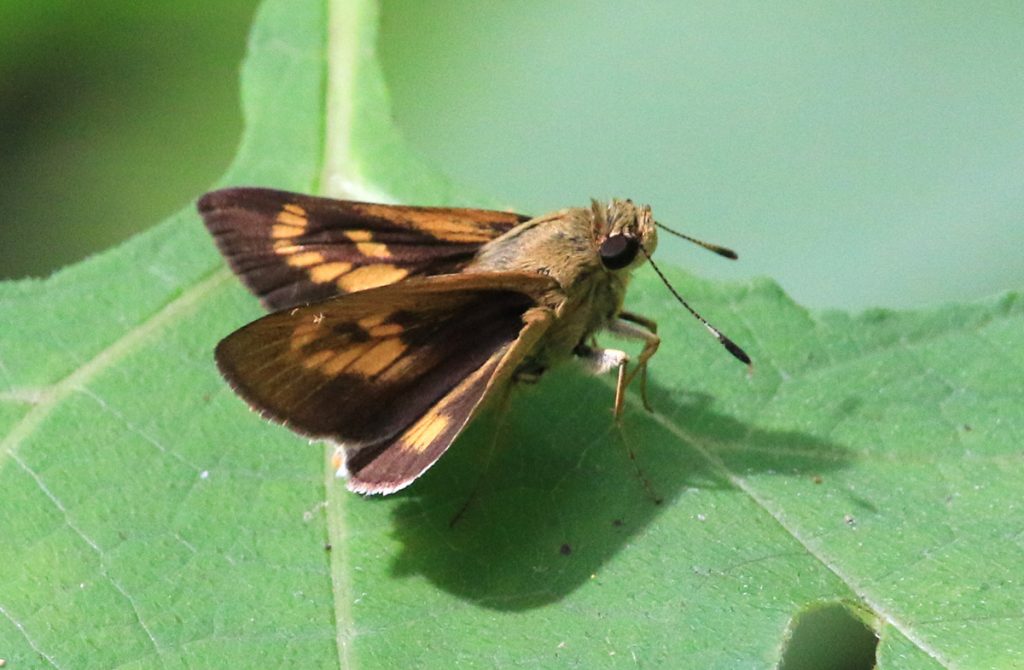

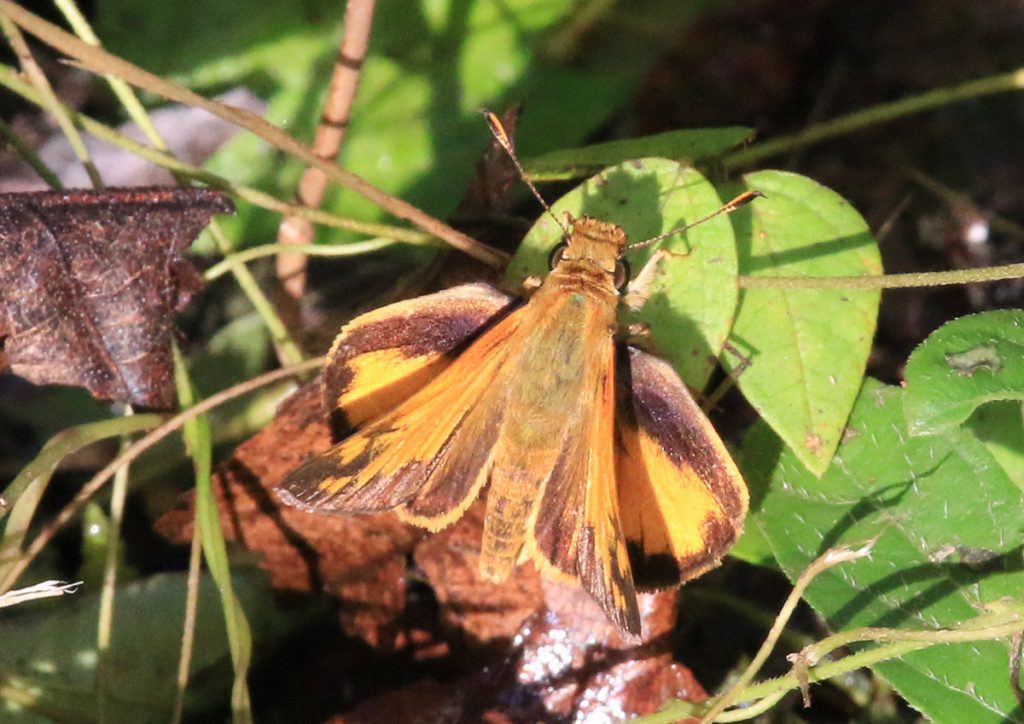

Here’s another look at a Zabulon skipper. We saw its outer wings earlier as it nectared on a sunflower; here we see its topside as it suns.


I only shot the one photo of this bee while it rested briefly. An entomologist iNaturalist user suggested this genus. In my trips to Klapp-Phipps, I saw multiple species of sweat bees, leafcutters, and bumblebees, as well as one species each of resin bee and cuckoo bee. I also saw honeybees high up where I couldn’t photograph them closely.
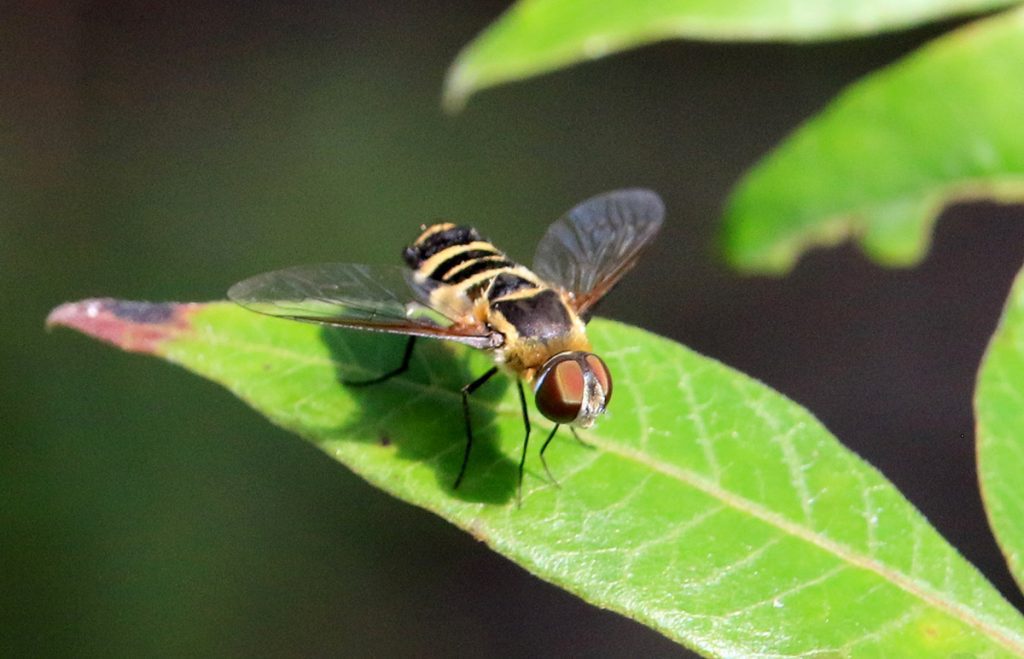

I originally thought, based on those eyes, that this was a hoverfly, the species of which are bee and wasp mimics. After running this through iNaturalist, I’ve learned about this other family of bee mimicking flies. While hoverfly larvae are predators (of aphids, specifically), bee flies parasitize other insect eggs and larvae.
4. Carolina Ruellia and Butterfly Pea
I included one shot of each of these purple flowers receiving pollination in the video. In addition to that, I have a few other photos of insects on the butterfly pea.
The mowing that took place before my last visit removed a lot of the ruellia, and the sensitive plants we see in the next section.
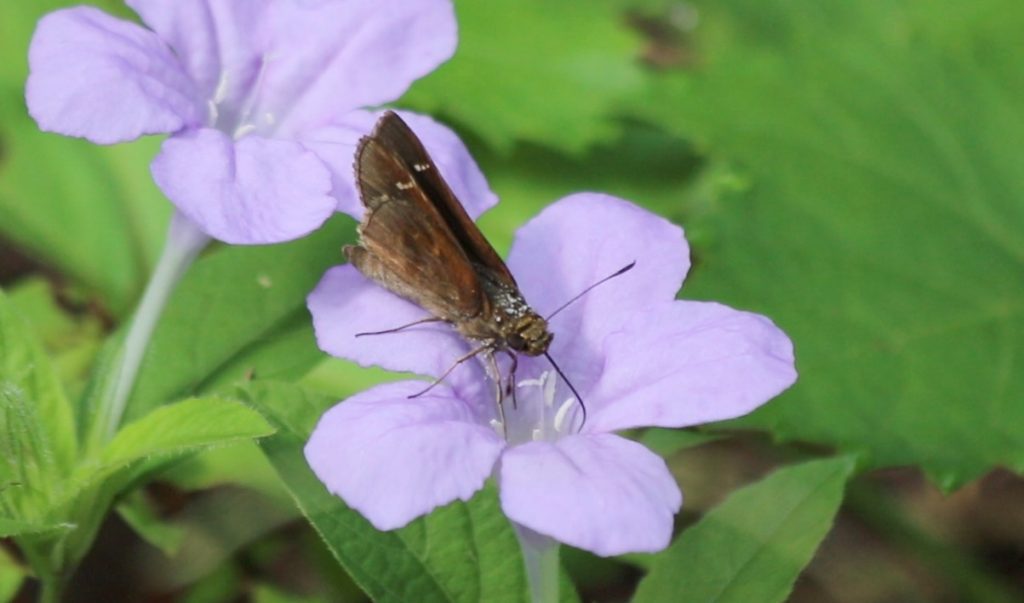

00:43 We’ve already seen a clouded skipper (Lerema accius) on woodland sunflower. Here, we can get a better look at its “cloudy” underwing. I love the way it walks all the way into the ruellia flower to drink its nectar.
00:50 Another feather legged scoliid wasp, which we saw on a sunflower as well. This time, it’s on the butterfly pea, which pollinators climb into.
Butterfly pea pollinators not in the video
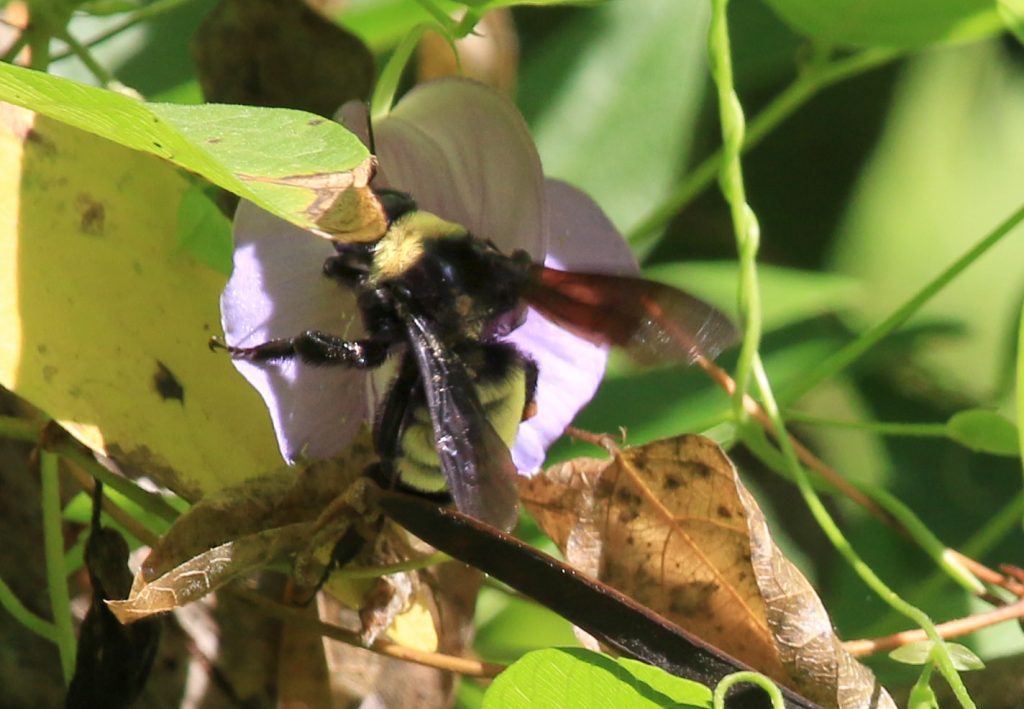

Along with seeing the golden-banded skipper, and the sheer volume and diversity of pollinators, this was the highlight of my three trips to Klapp-Phipps. This is the largest of our local bumblebees, and the yellow, striped patch on its abdomen is diagnostic: this is an American bumblebee.
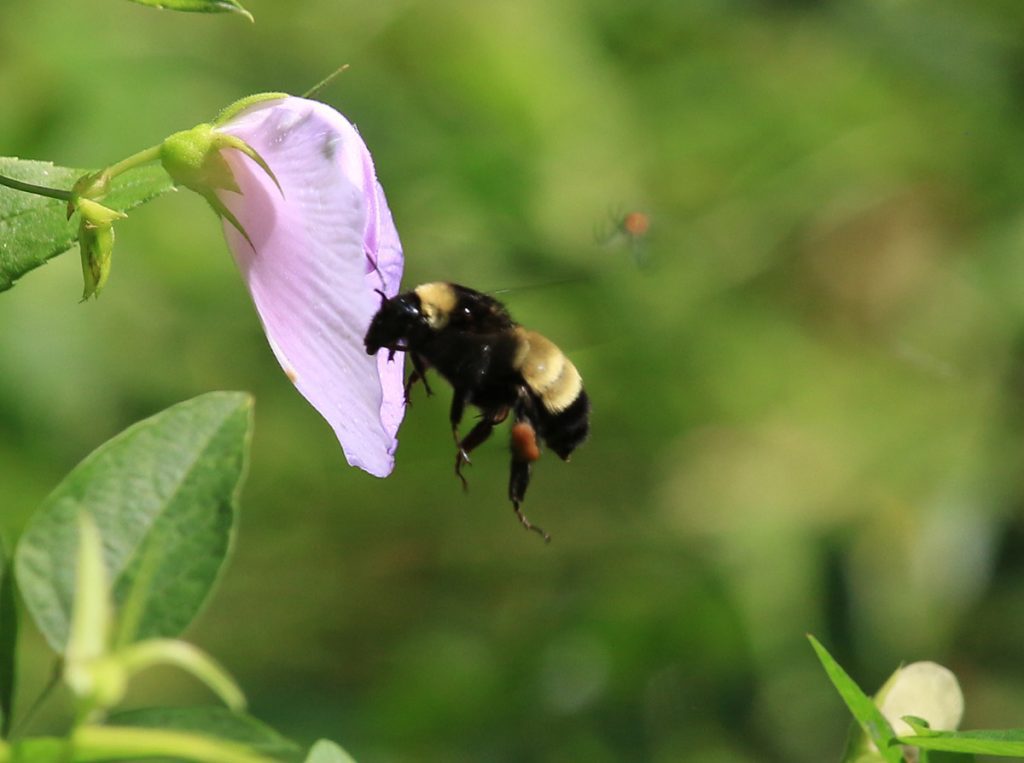

I had a hard time getting a good photograph. This American bumblebee was only pollinating the butterfly pea flowers. While it was inside, I tried to quickly set a focus before it jumped right back out again.
Bombus pennsylvanicus was once the most common bumblebee species in the United States, but is now Federally listed as Vulnerable, the level right below Endangered. Unlike other bumblebees, which are ground nesters, these nest above ground. You can see some footage of one of their nests in a video I produced last year.
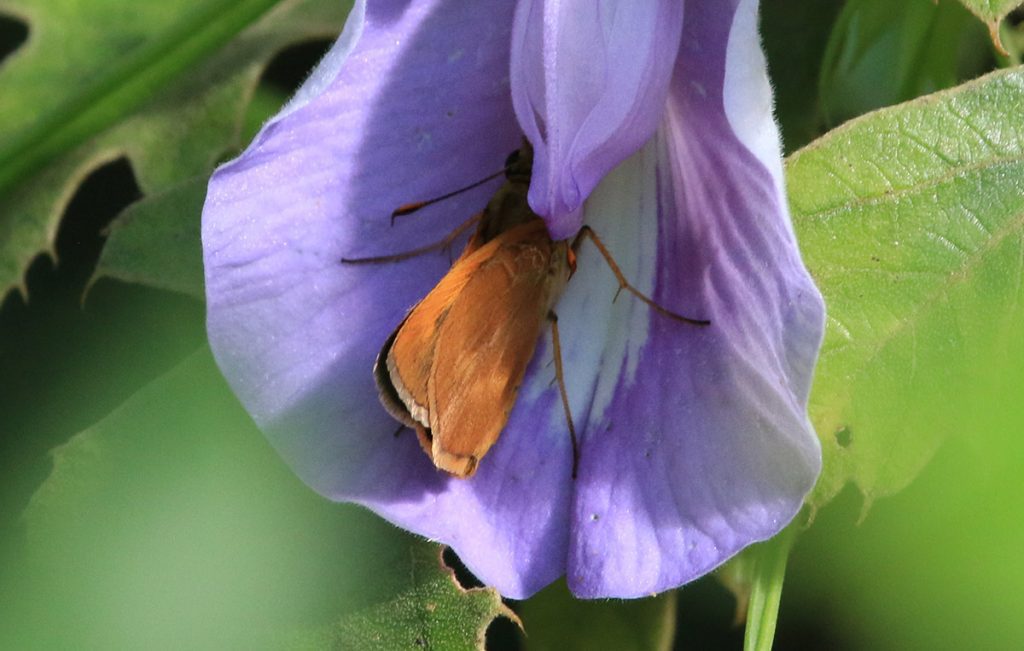

There are so many similar looking grass skippers. I’ve been identifying butterflies with a field guide and some Googling (some butterflies do have a lot of variation in their patterns). I took this one into iNaturalist, and for now, I’m saying this is a southern broken dash (it has since been confirmed). Here’s another look at the butterfly on the same flower:


Here’s an insect eating the flower itself:
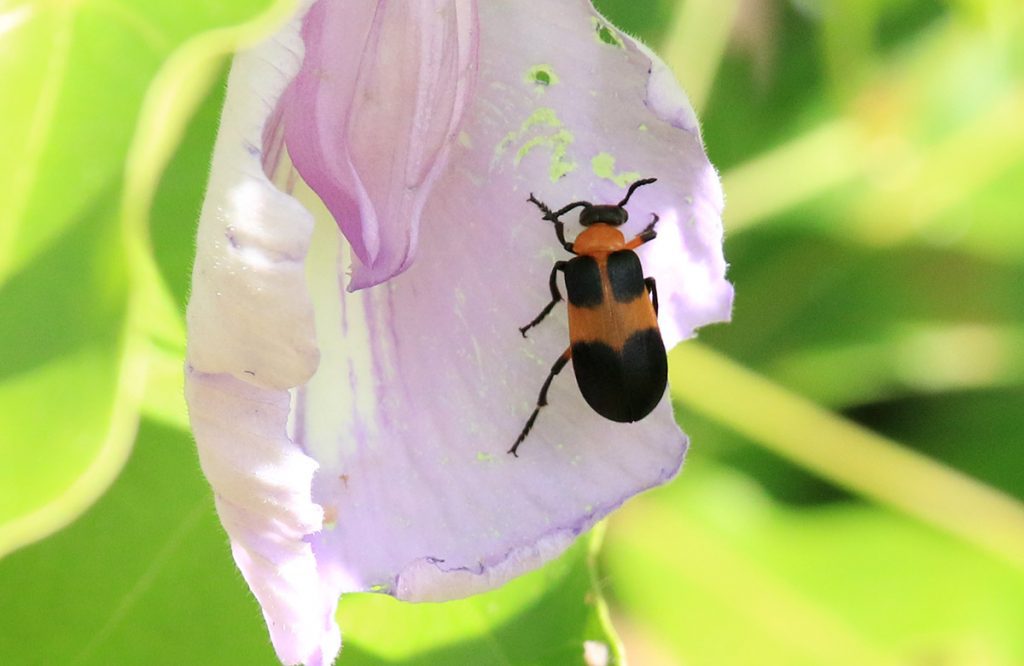

This blister beetle is eating little holes in a butterflypea flower. Blister beetles are also parasitoid breeders, and their larvae usually feed on bees.
5. Sensitive Plants
This is a different species of sensitive plant than I have in my yard. But both have these pink puffball flowers, which bees dive right into. This is the littleleaf sensitive-briar (Mimosa microphylla). Mimosa is the genus name for sensitive plants, but it is also the common name for a tree in the Albizia genus, which is an exotic invasive.


00:57 A species of Augochlorine green sweat bee. In iNaturalist, I guessed metallic epauletted-sweat bee (Augochloropsis metallica). Looking at its abdomen in the video, I thought the way it was segmented looked more like that than a pure green sweat bee. But they look very much alike, and it takes clear photos of every part of one of these bees to make a sure choice. I haven’t received confirmation of my guess.
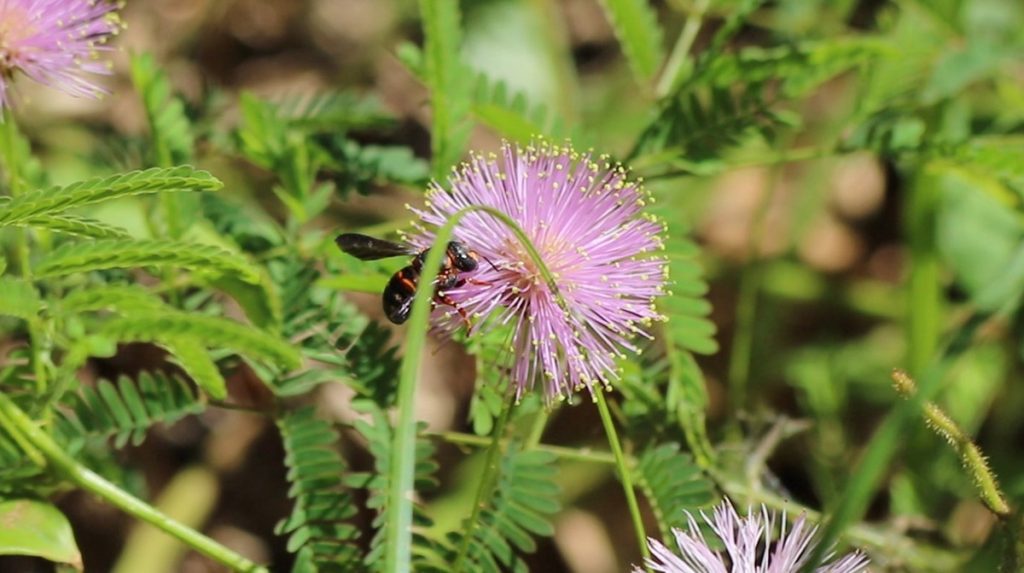

01:05 Perplexing rotund-resin bee (Anthidiellum perplexum).
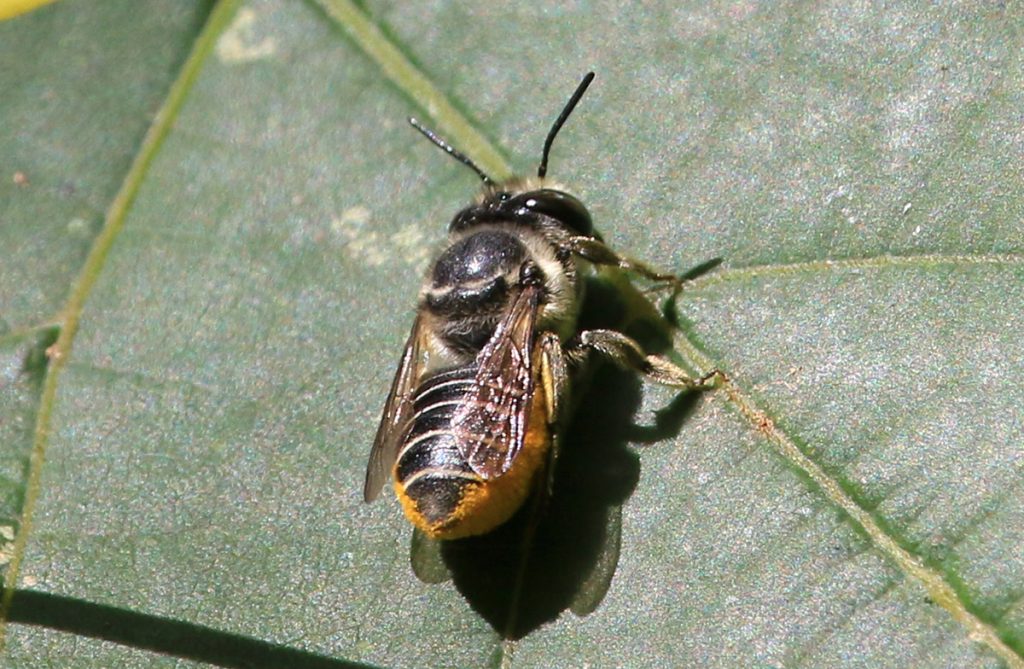

01:11 Leafcutter bee. I saw the same bee somewhere else in the park, and so here’s a better still shot than I could pull from the video. I entered it as a flat-tailed leafcutter bee into iNaturalist. An entomologist specializing in bees suggested this related, and similar looking species. This is the third different leafcutter bee species we’ve seen at the park.
One more pollinator on a sensitive plant flower
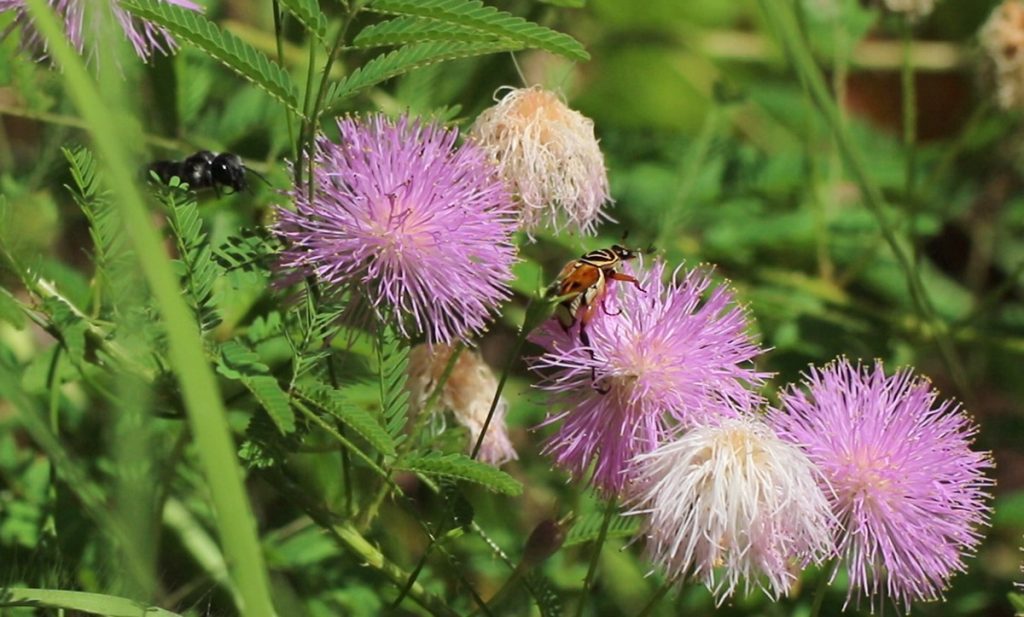

Here’s a pollinating beetle, with a bee coming in from the left. The ensuing collision sent them off in either direction.
6. Butterfly milkweed (Asclepias tuberosa)
Where the trail intersects the powerline cut, there were a couple of nice patches of butterflyweed. I looked them over, and saw no evidence of anything eating their leaves. But, while I didn’t see any monarch caterpillars, there were plenty of other insects on the milkweed flowers.
01:16 Another green metallic sweat bee (not pictured).


01:22 Cloudless sulphur (Phoebis senna). There were a few of these around the milkweed.
One more butterfly species seen on milkweed
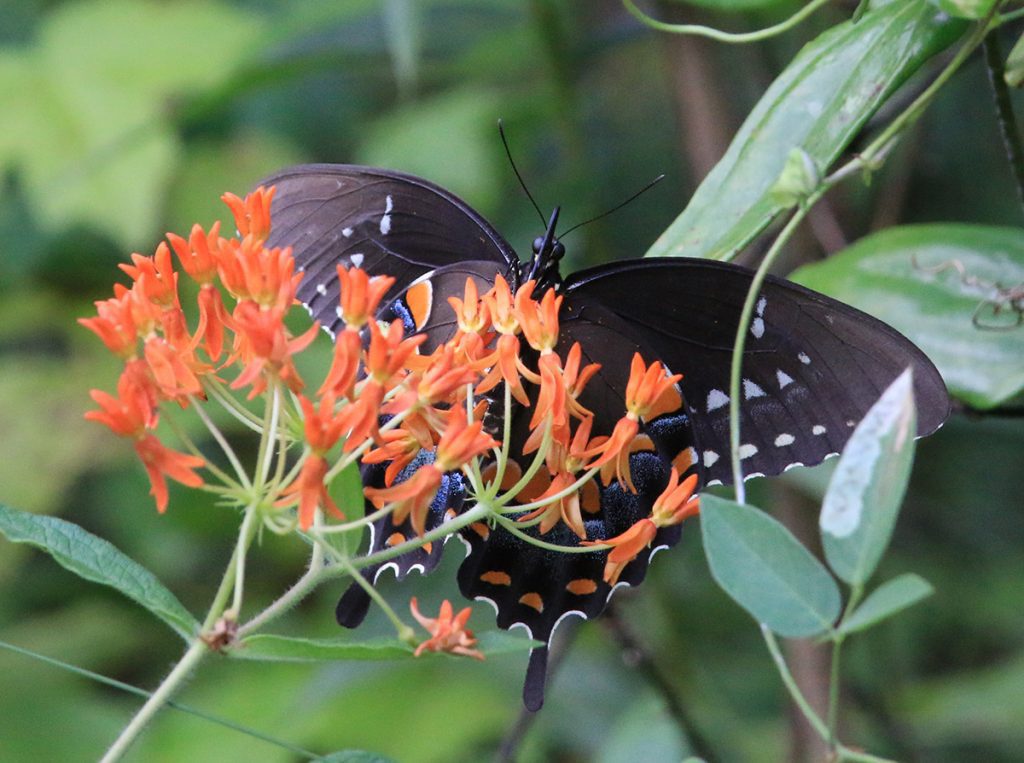

I saw two of them. The one above was trying to feed itself, but the other one kept approaching it, I’m guessing to mate. For the one above, feeding was the priority that day. Below is the rejected party, sulking on a nearby leaf:
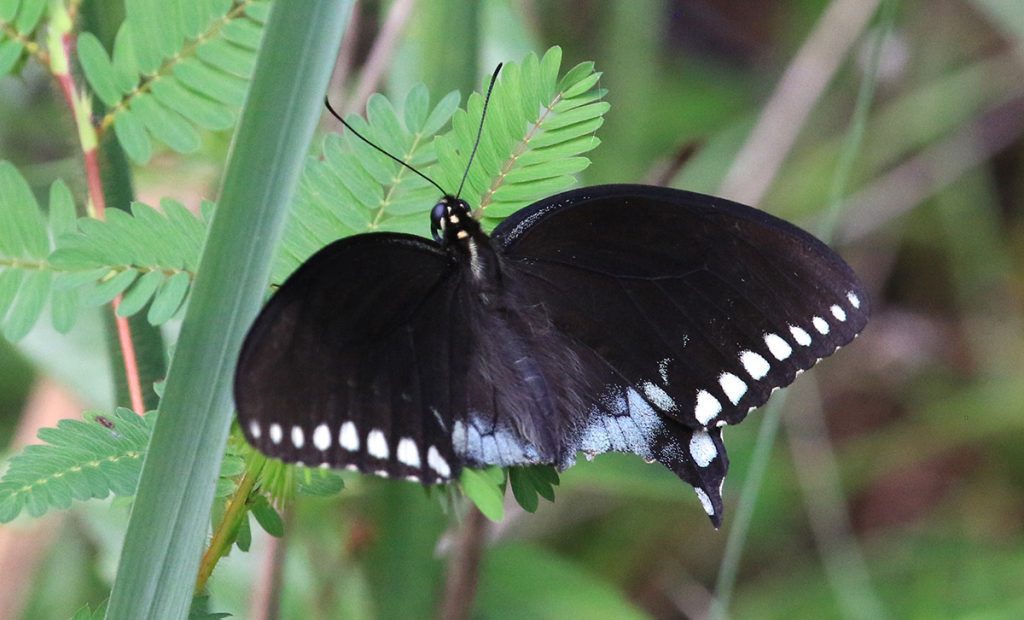

7. Devil’s Walkingstick
What fun name for a plant. The flowers on this tree are kind of high up, so though they were choc-full of pollinators of every size and shape, I was only able to clearly make out the larger insects. The blooms with less bees and wasps attracted large butterflies. And there was one wasp large enough to shoot closer up.
Two weeks passed between my second two visits, on July 9 and July 23. My first trip was July 1. On those first two trips, several devil’s walkingsticks were in bloom. Returning two weeks later, the blooms were mostly spent, and the plants had gone to seed.


July 9- Devil’s walkingstick flowers, full of bees and wasps. 
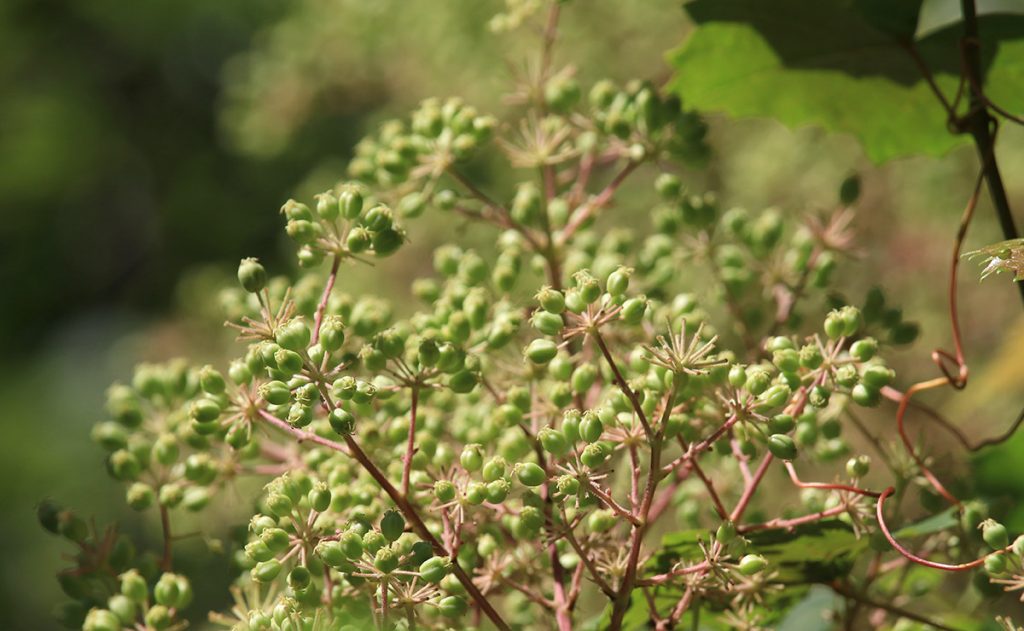
July 23- Devil’s walkingstick gone to seed.
So, what did I see on Devil’s walkingstick when it was in bloom?


01:26 This was as far I could zoom into the bloom. I can make out several bumblebees (all black abdomens, so not American bumblebees). I did see honeybees. In the lower left of the shot, a dark hairstreak butterfly- maybe a great purple? There are also several wasps and other dark shapes. Maybe next year I can return with a more powerful lens (or a ladder)?
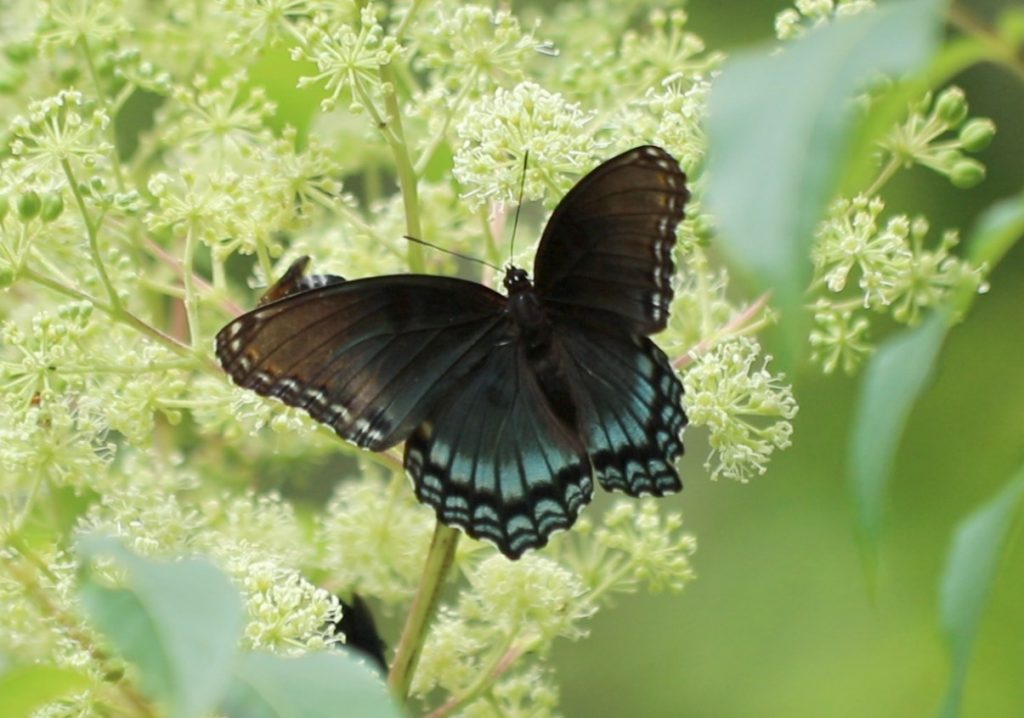

01:29 Red-spotted purple (Limenitis arthemis). At 01:30 you can see a green sweat bee bounce off of its wing. Perhaps butterflies avoid the blooms with more bees and wasps because they otherwise take a beating?
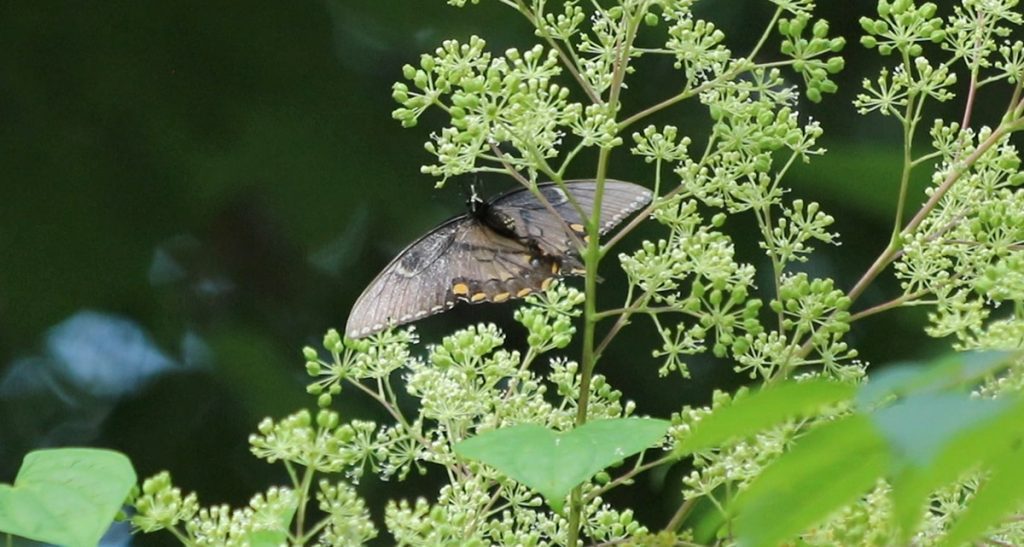

01:32 It took me a while to identify this one. It has the swallowtail shape, but it doesn’t have the second row of colored spots we see in other species with black undersides. This is a black morph of a butterfly we see more of in a second, the tiger swallowtail.


01:36 Tiger swallowtail (Papilio glaucus). I saw two with the usual coloration, though I only included this closeup.


01:41 Great black digger wasp (Sphex pensylvanicus) is a wasp that’s one to one-and-a-half inches long, so it’s hard to miss. Also, it’s entirely black. It’s the Darth Vader of wasps.
01:44 Here, we see a golden-banded skipper on devil’s walkingstick. When it was done, it flew off onto a nearby leaf and let me photograph it. Again, not many butterflies are so cooperative.


And so, we end the video as we started, with this rare butterfly.
Other plants and animals I saw at Klapp-Phipps park
Partridge Pea
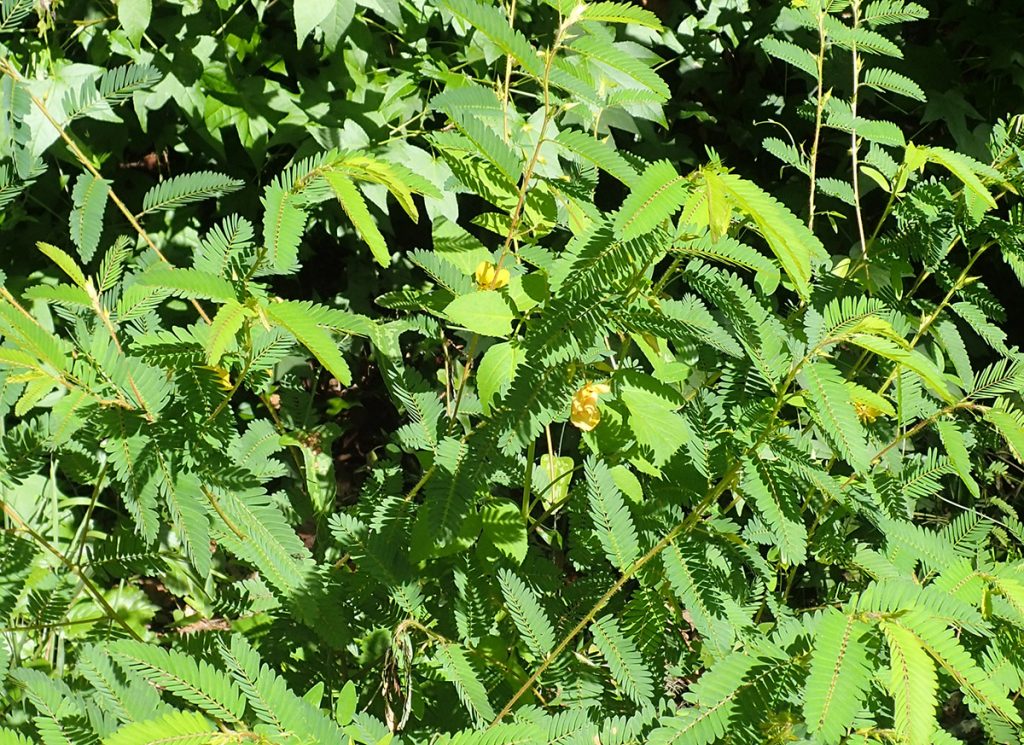

I’m not sure why I didn’t notice it on my first two trips. It usually starts blooming in July, and so maybe there weren’t flowers on my first two trips earlier in the month. This is a larval food for the cloudless sulphurs we saw seeking nectar on milkweed.
Here’s a look at a bee pollinating one of its flowers:
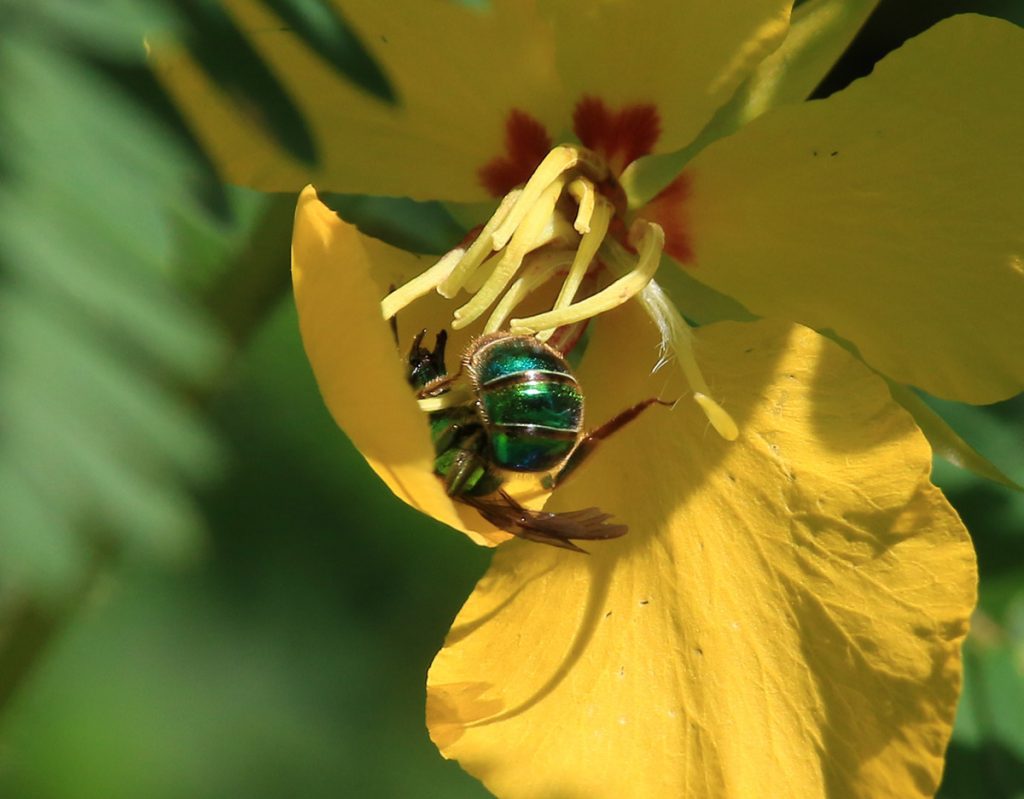

Looking at the striping on its abdomen, I think this is a female brown-winged striped sweat bee.
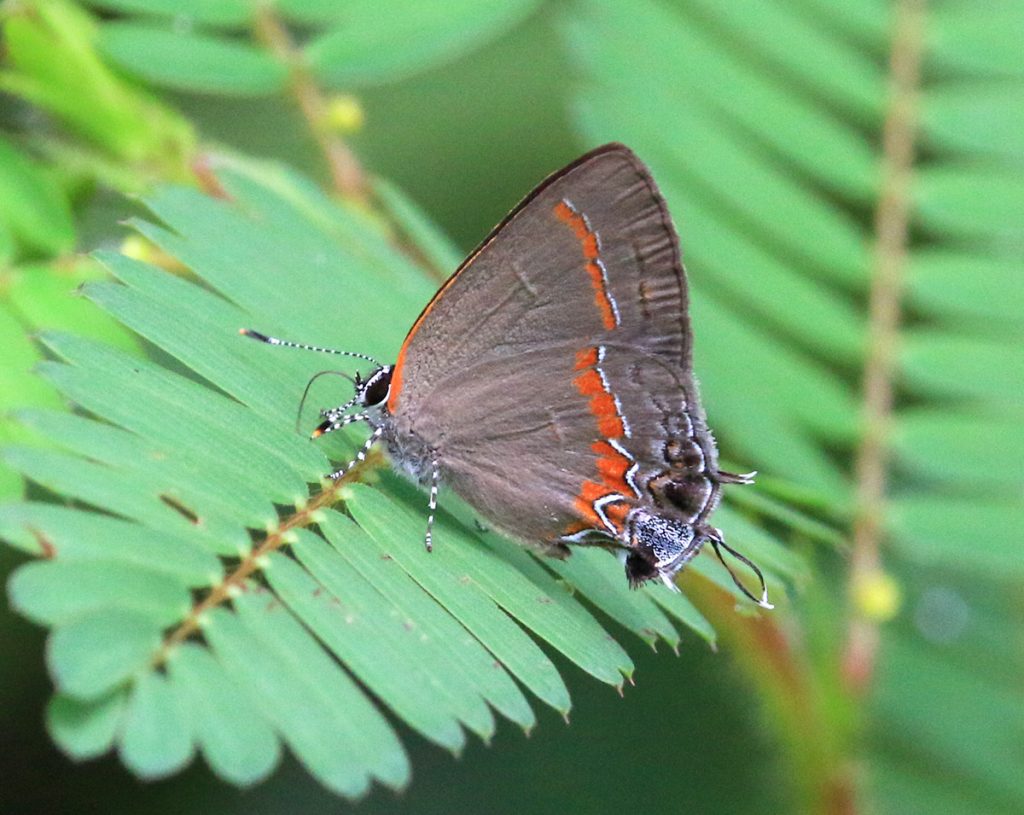

Coral Bean, or Cherokee Bean (Erythrina herbacea)
I was curious about a plant I saw, because of these cool red seeds I saw in an open pod. So I photographed the leaves and uploaded to iNaturalist.
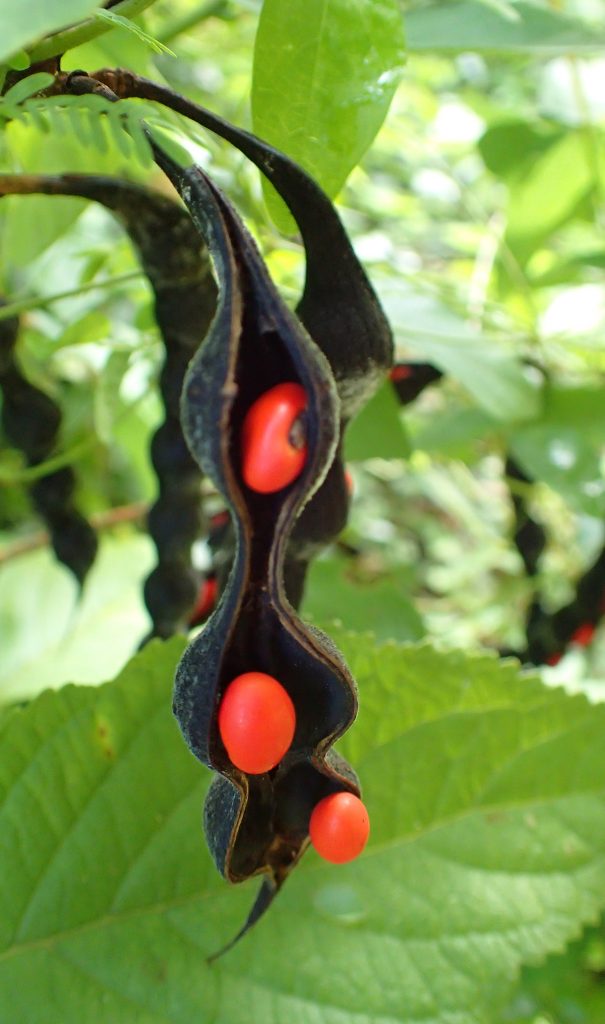

Here’s it’s leaf:
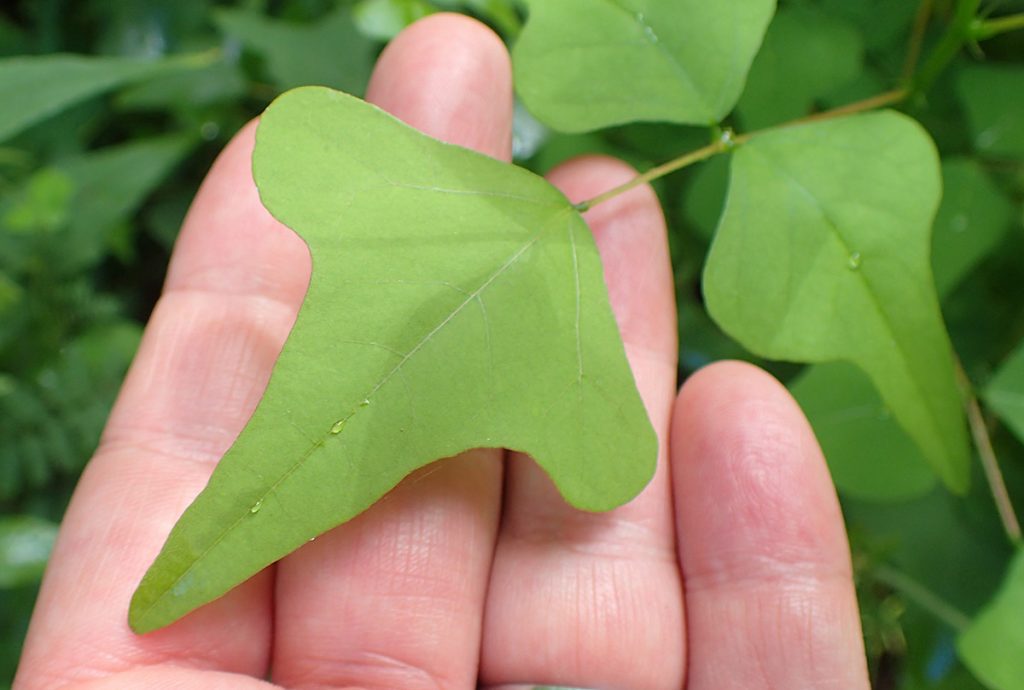

This plant’s flowers are popular with hummingbirds.
Golden silk spider (Trichonephila clavipes)


These impressive spiders were conspicuous not far from clusters of sunflowers.
Yellow gardener spider (Argiope aurantia)
Here, we have another large spider, a yellow gardener spider, that seemed to have caught a butterfly:
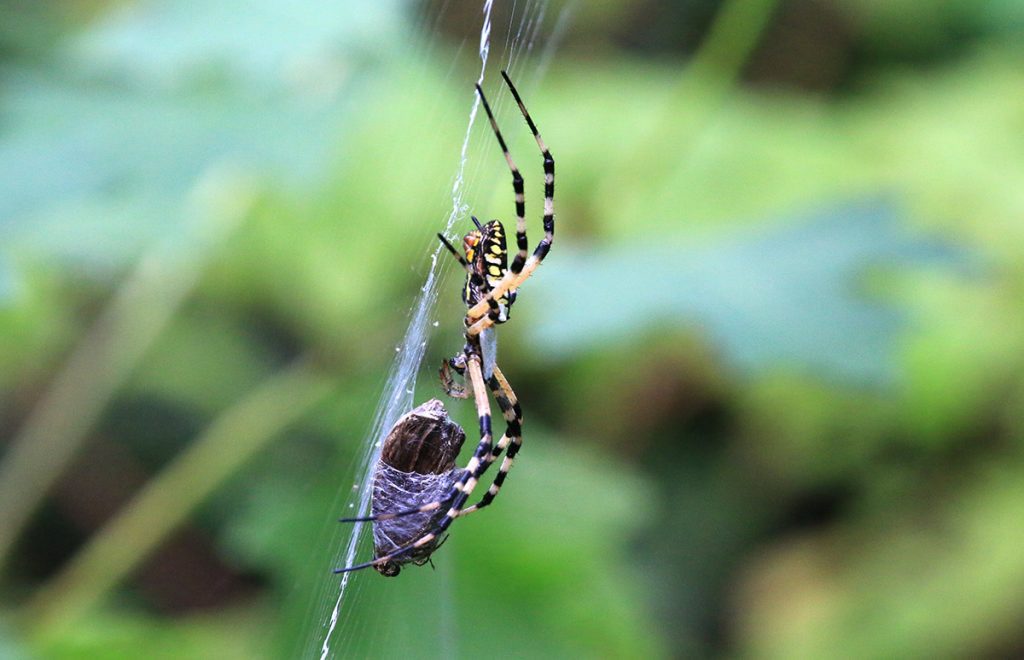

I saw this right next to where I was photographing a couple of golden-banded skippers. Might this have been one of those rare butterflies? I’m not sure, but it happens.
Space, habitat- these are the best protectors of a species. Larval food plants for their caterpillars, flowers for the adults, and plenty of places to shelter and catch sun. Predators will eat their share, and those best at avoiding this fate pass on their genes. Of course, the predators best at catching them and other butterflies pass their genes on, too. Part of what makes this a functioning habitat is this food web; animals eat plants, and other animals eat those animals.
In this quarter mile stretch of Elinor Klapp-Phipps Park, on three trips over three-and-half-weeks (for a total of six hours), what did I see? Nineteen butterfly species. Nine or more bee species. Three wasps, and four insect predators. I’m only counting the species I could photograph close up; there were many more up high in the devil’s walkingstick and flying quickly past me
One of the butterflies I saw was state listed, and one of the bees federally listed.
I have a big project coming up, but I think I’ll do this same kind of video/ photographic exploration of other places in the WFSU viewing area when I have time. I have repeatedly visited the Munson Sandhills over the years, seeing the flora and fauna in different seasons, and its wetlands during their wet and dry periods. But what other spots can I visit a few times within a month, and get to know the character of its habitat? I’ll have that in my mind, and I’m open to any suggestions.
I usually include the following citizen science block on Backyard Blog posts, but any of these apps/ programs can be used anywhere with pollinator habitat:
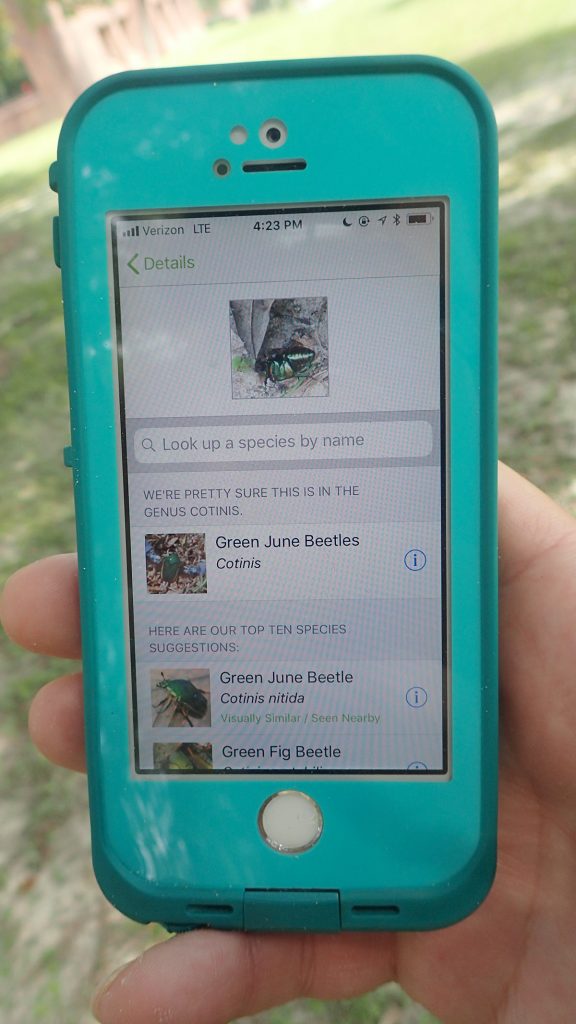

Apps and Citizen Science mentioned in the Backyard Blog
iNaturalist
Identify plants, animals, lichens, and fungi in your yard. Other users correct your identifications if you’re wrong, and even if they don’t, it can be a good springboard to further research.
Seek by iNaturalist
Instant identification, and it doesn’t record your location. This is a good option for kids with phones.
Monarch Larva Monitoring Project
Enter information about monarch caterpillars in your yard, and help researchers get a sense of the health of the monarch population that year, and how and when they’re migrating.
Great Sunflower Project
Record the number of pollinators visiting your flowers, and help researchers map pollinator activity across the country.

